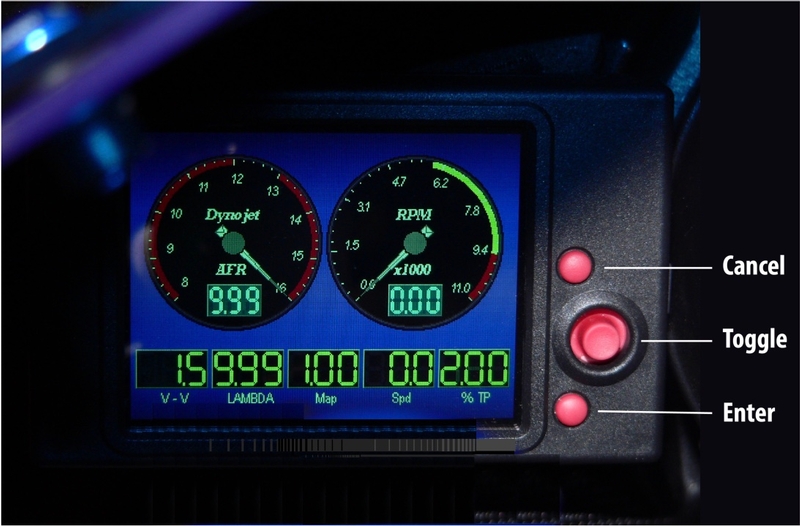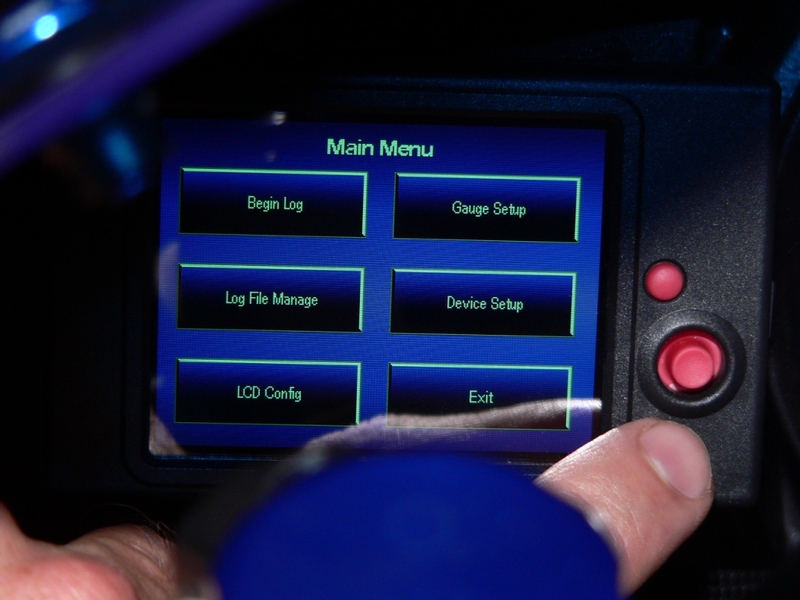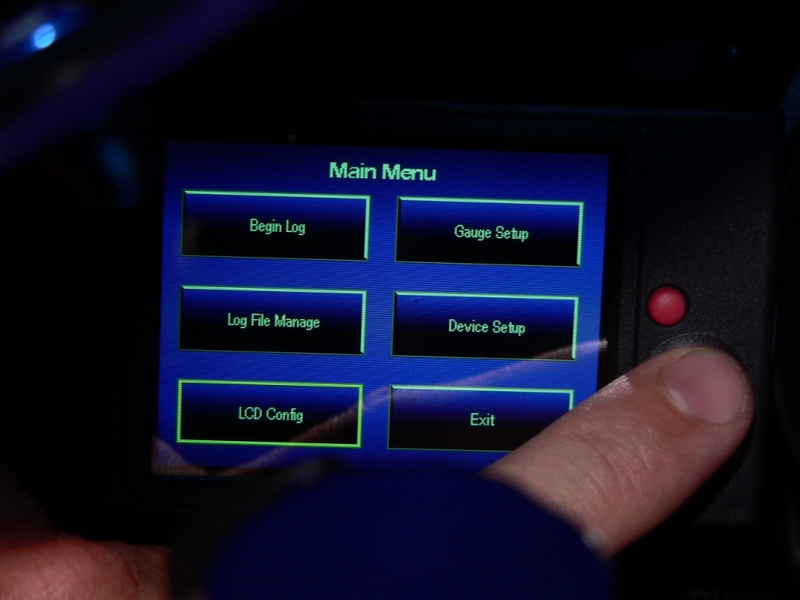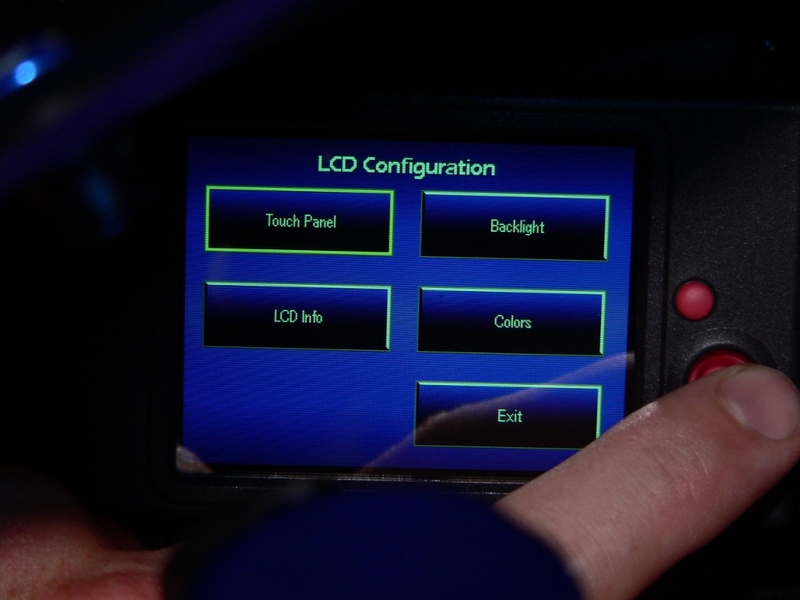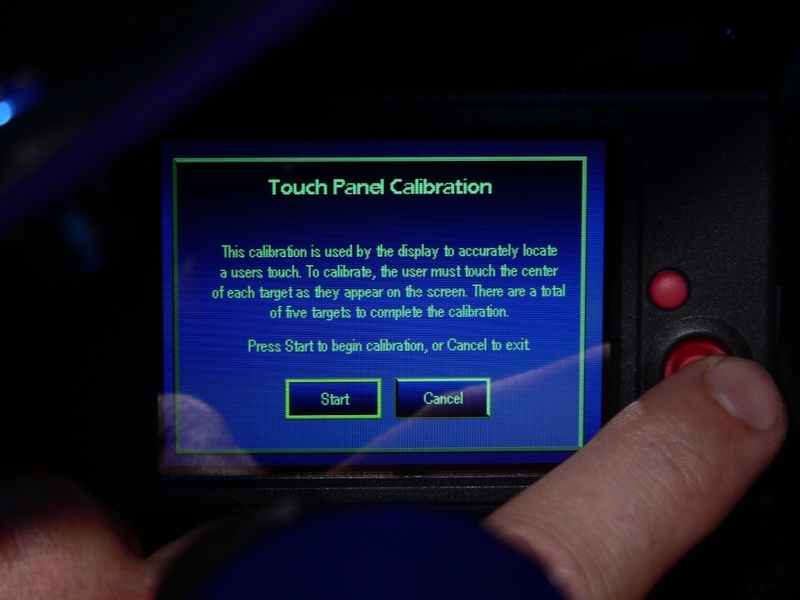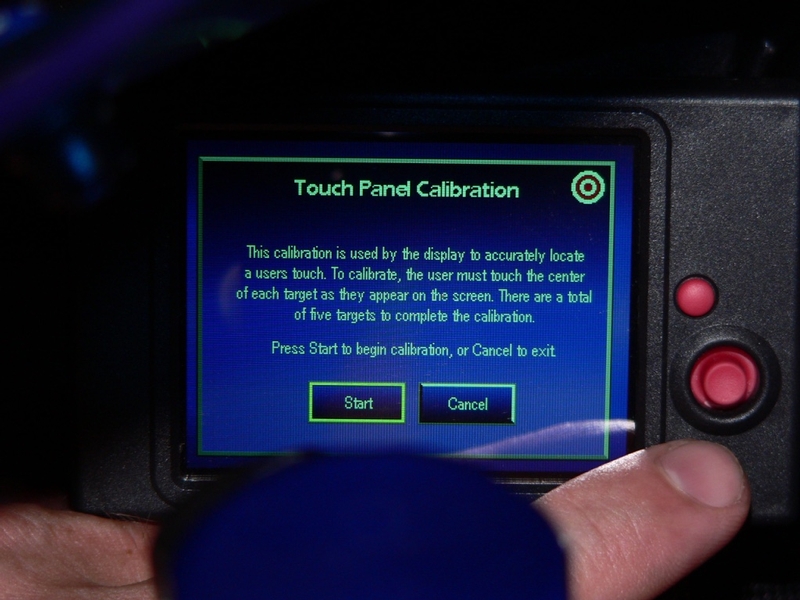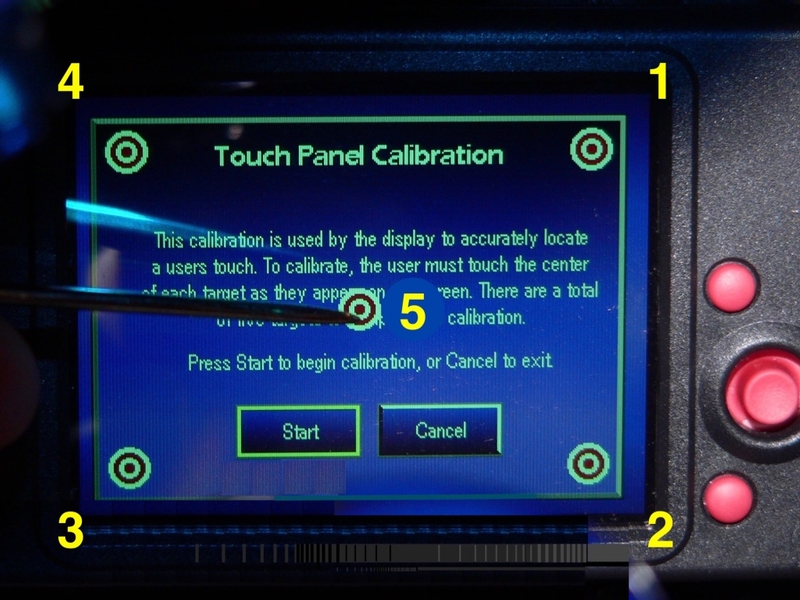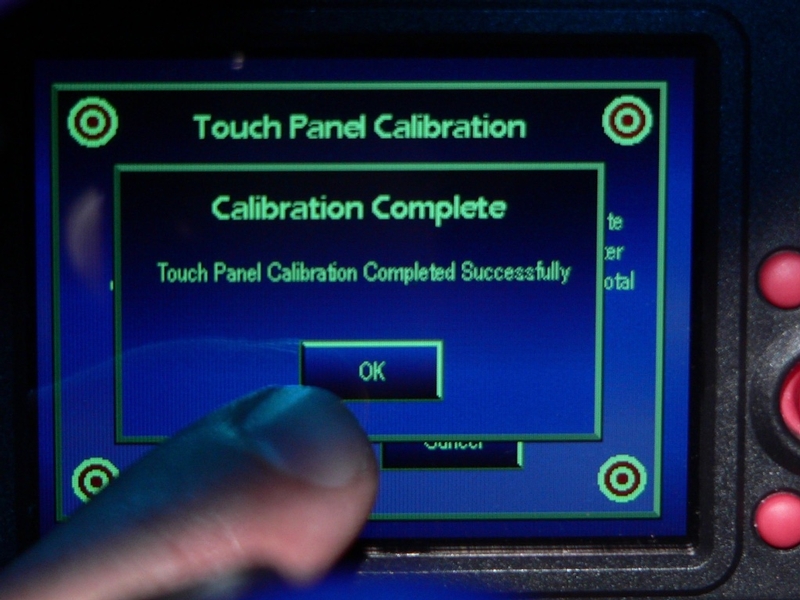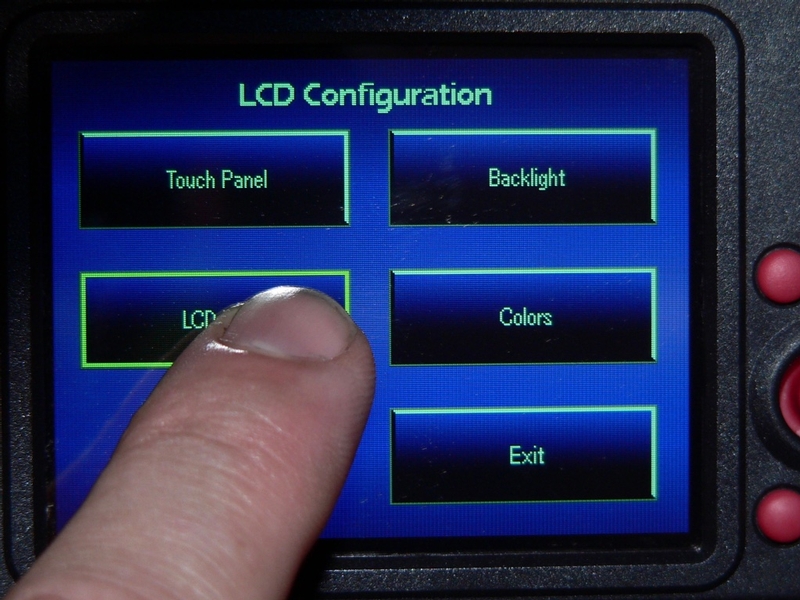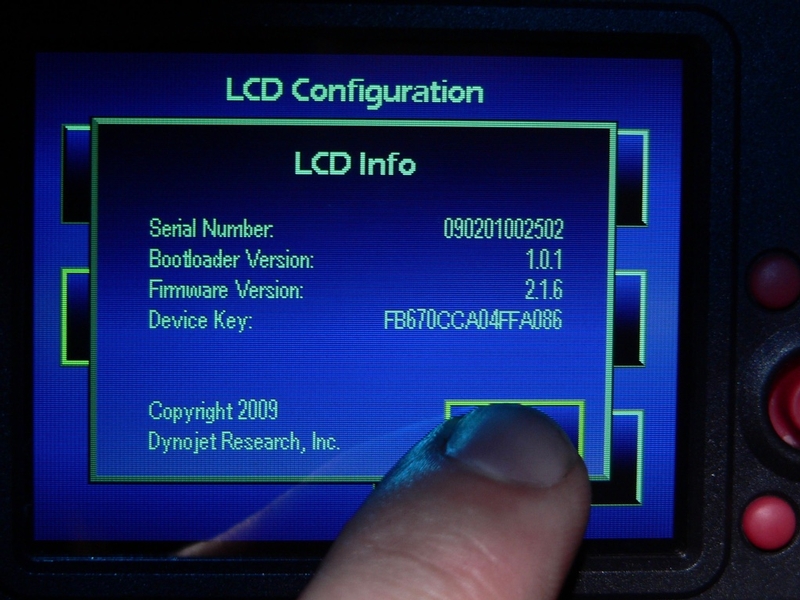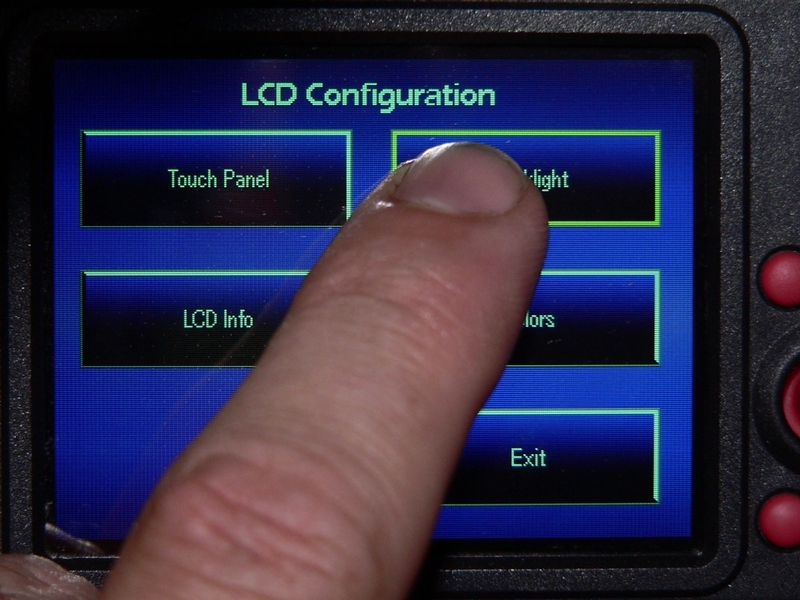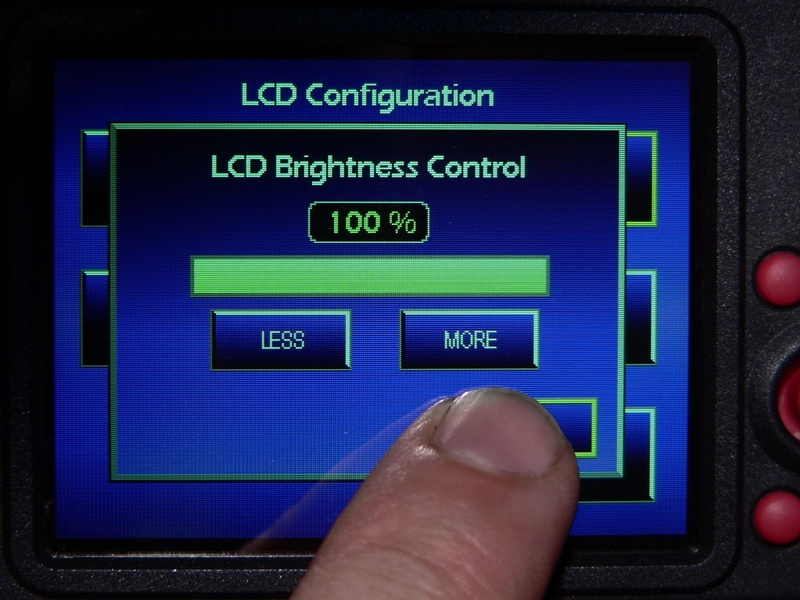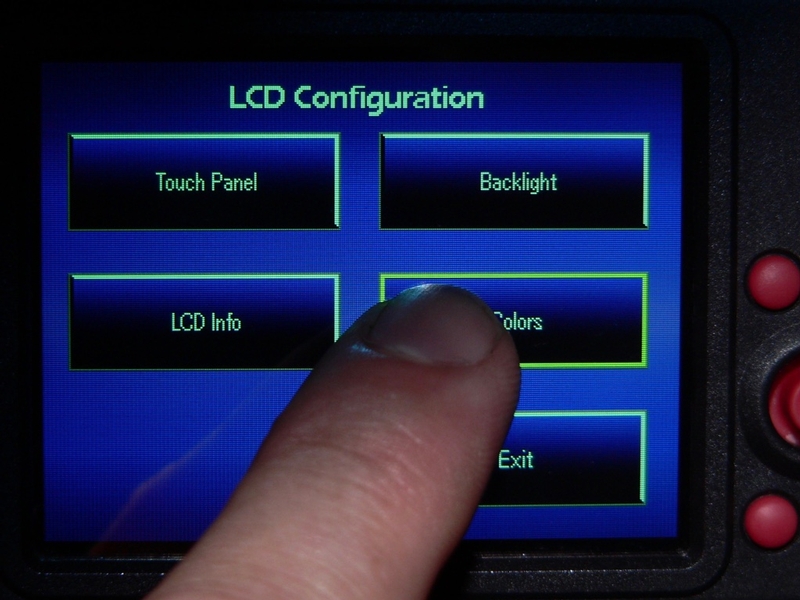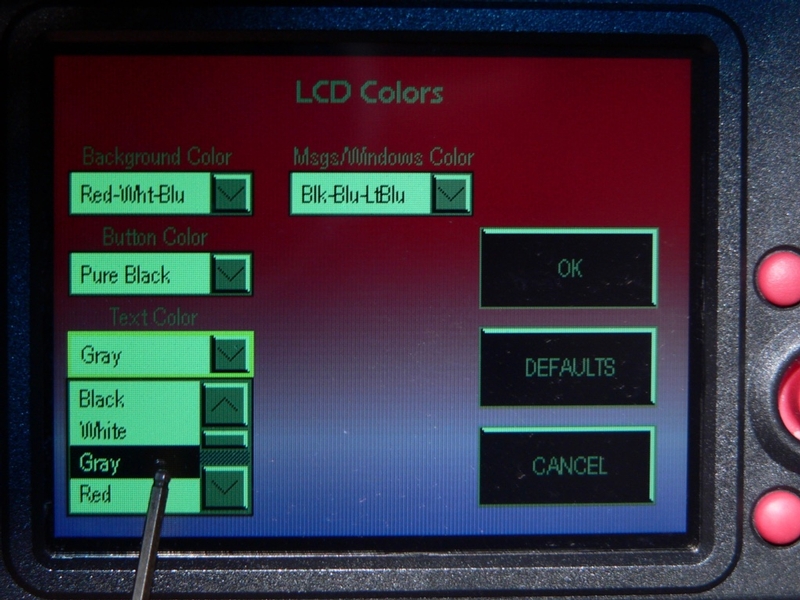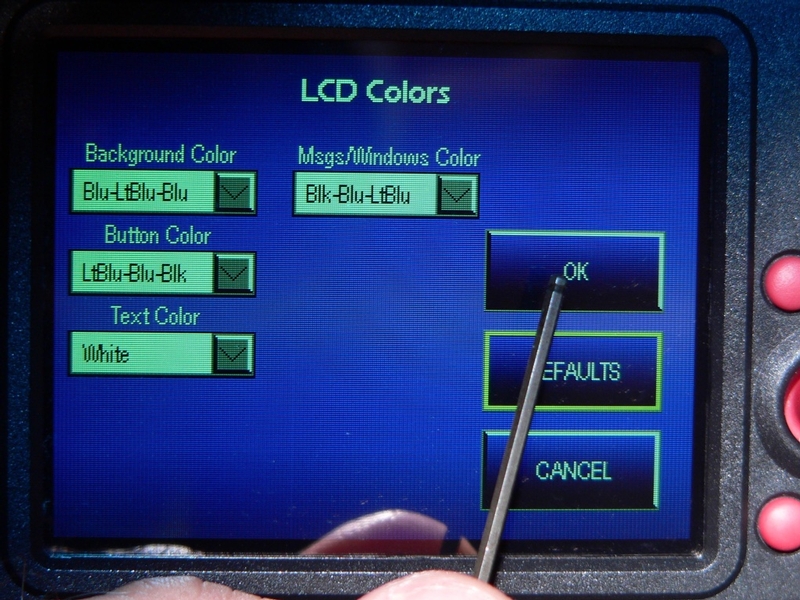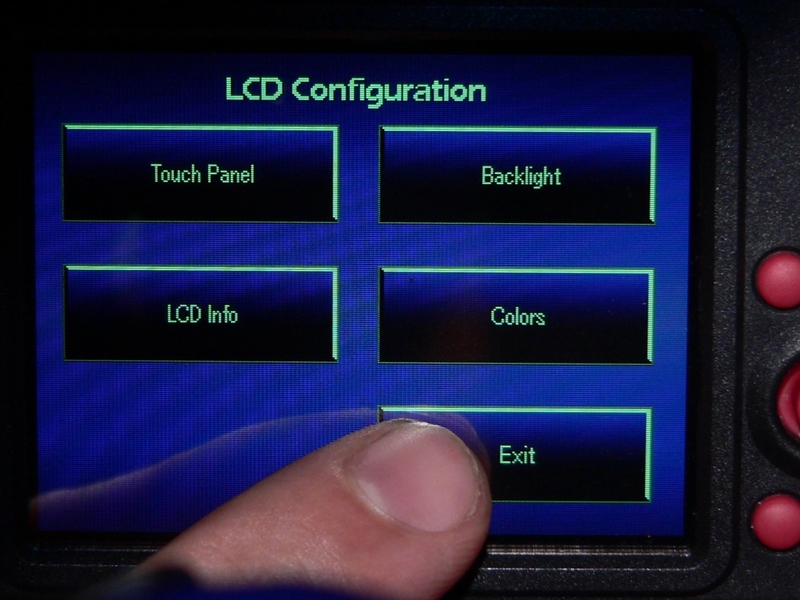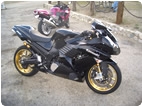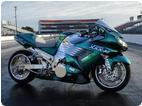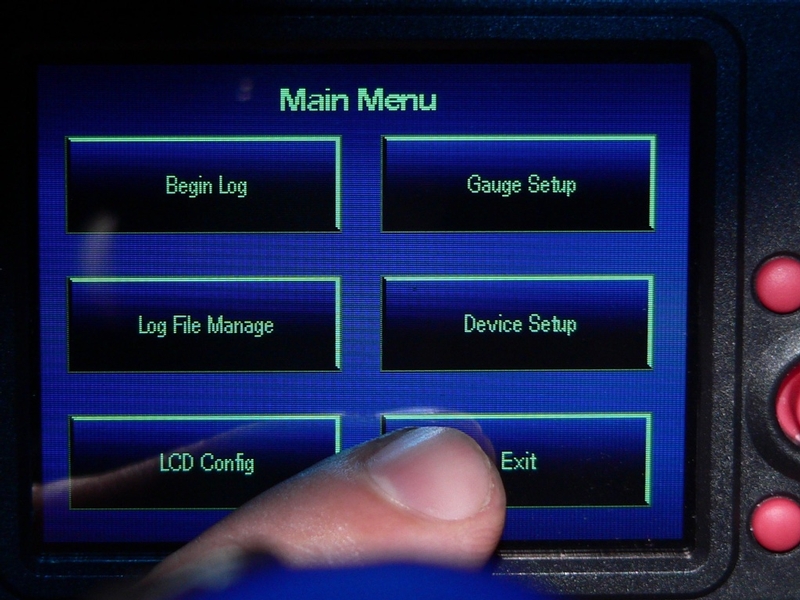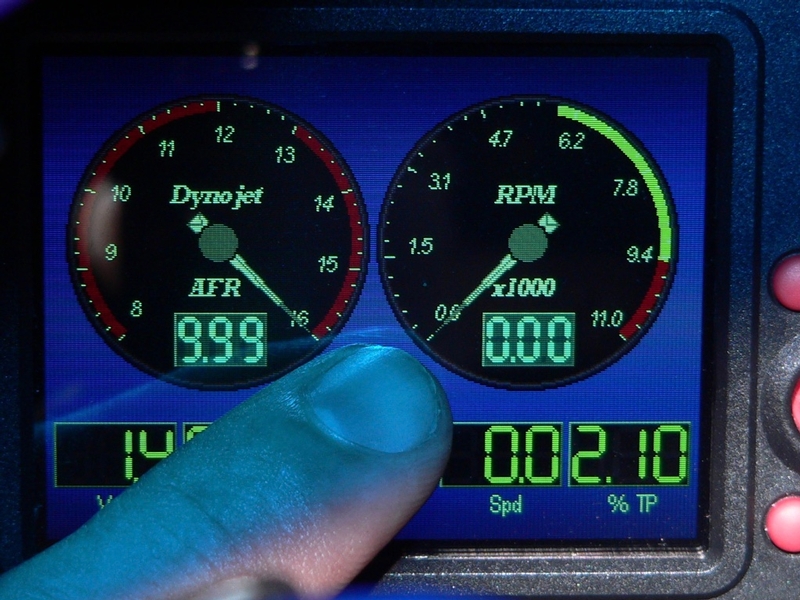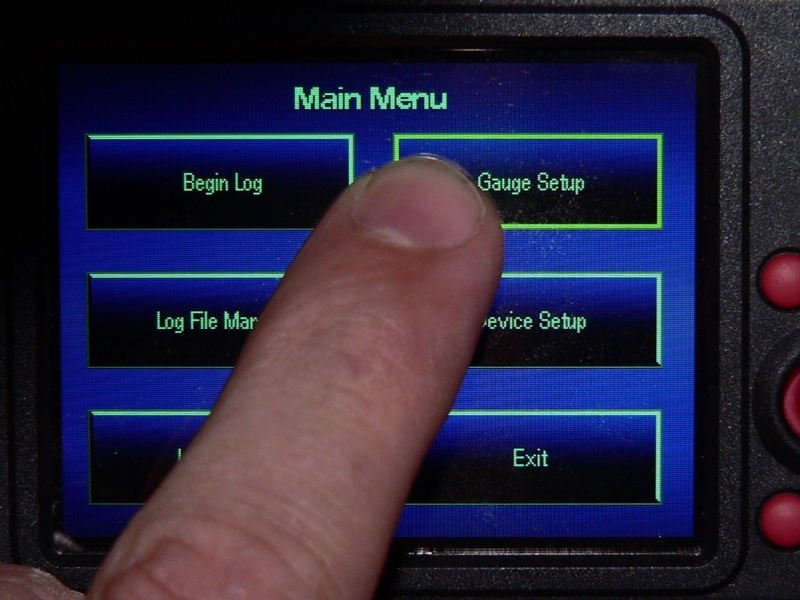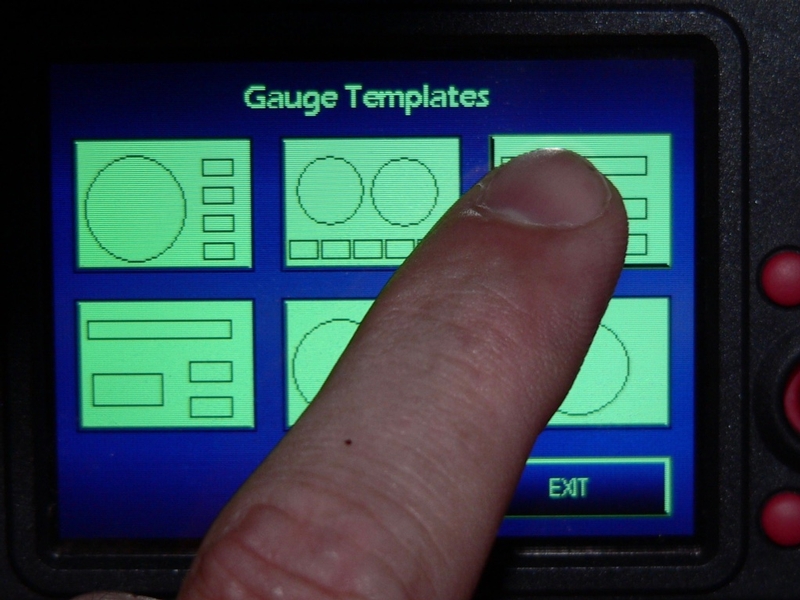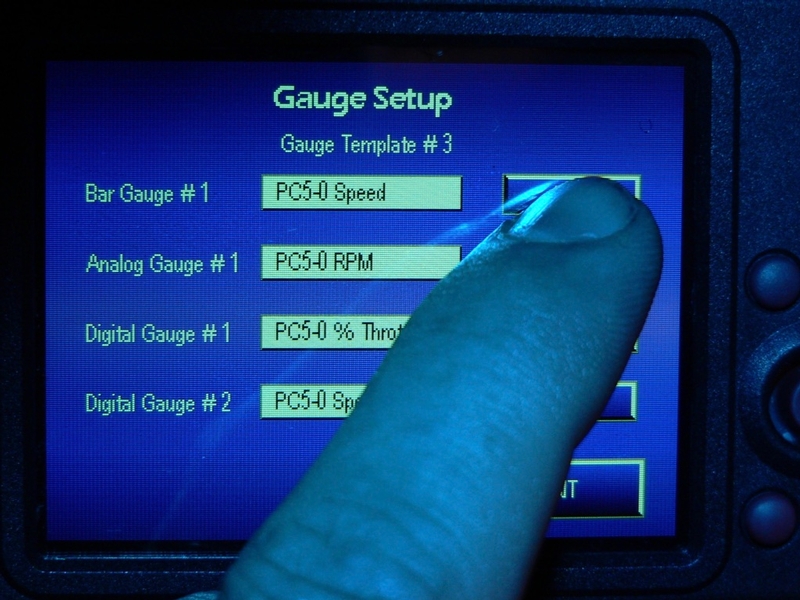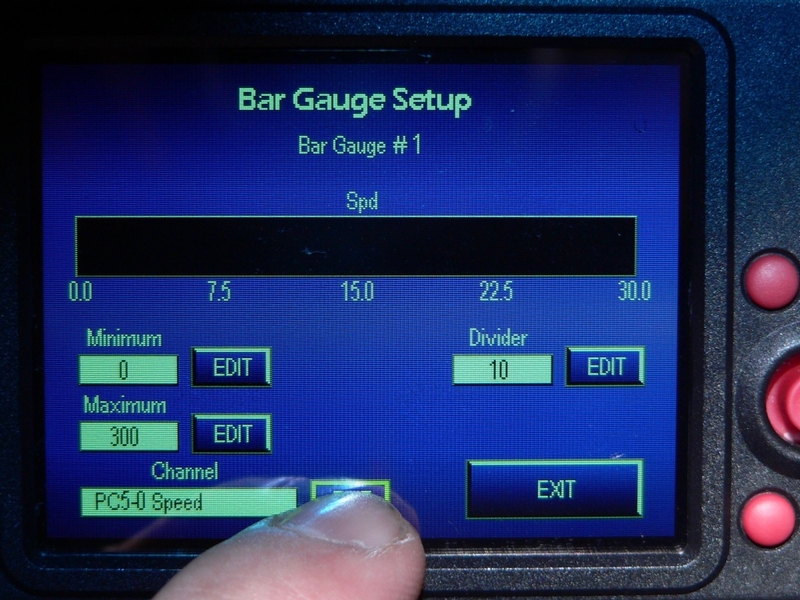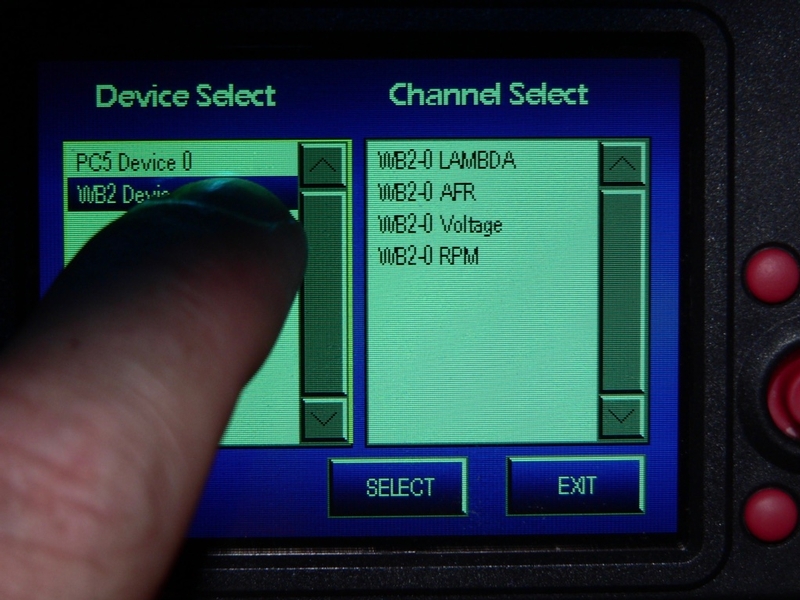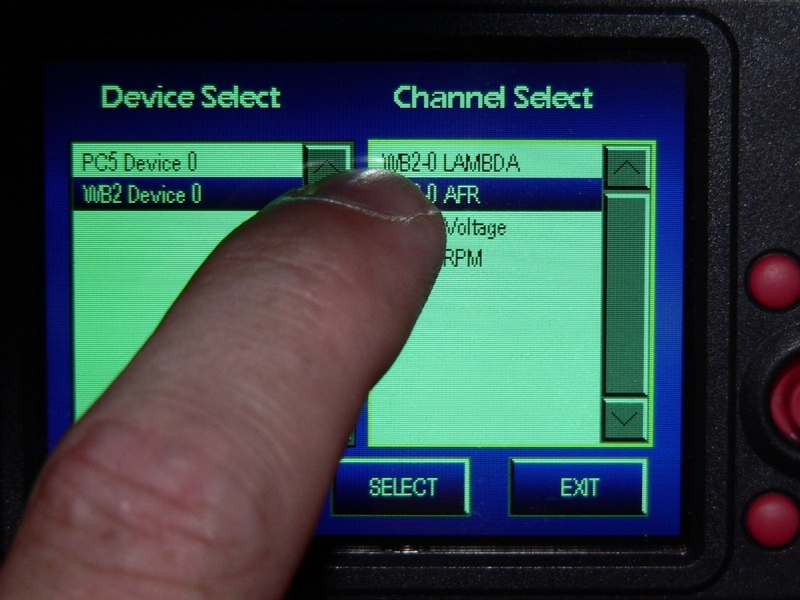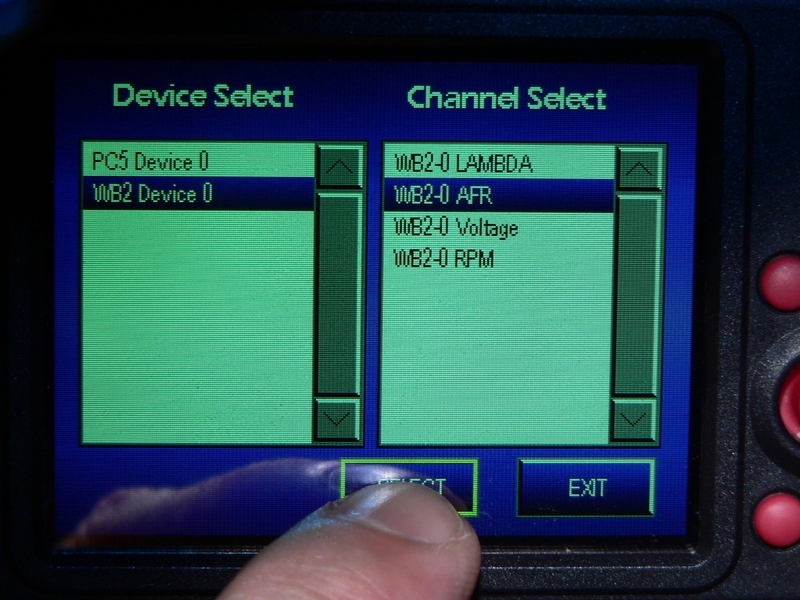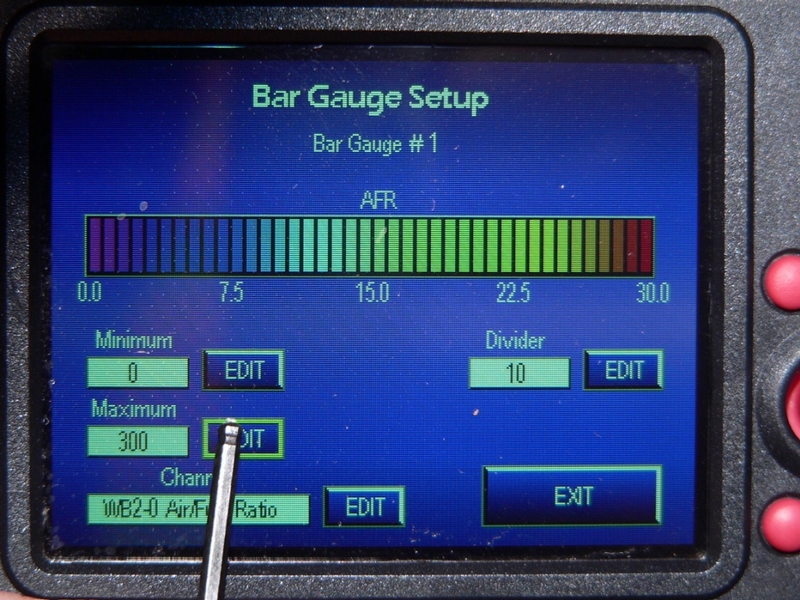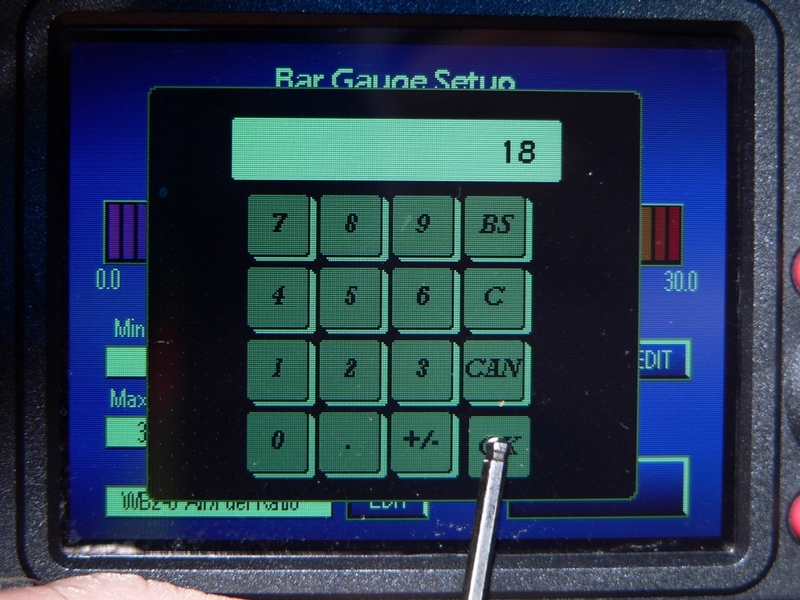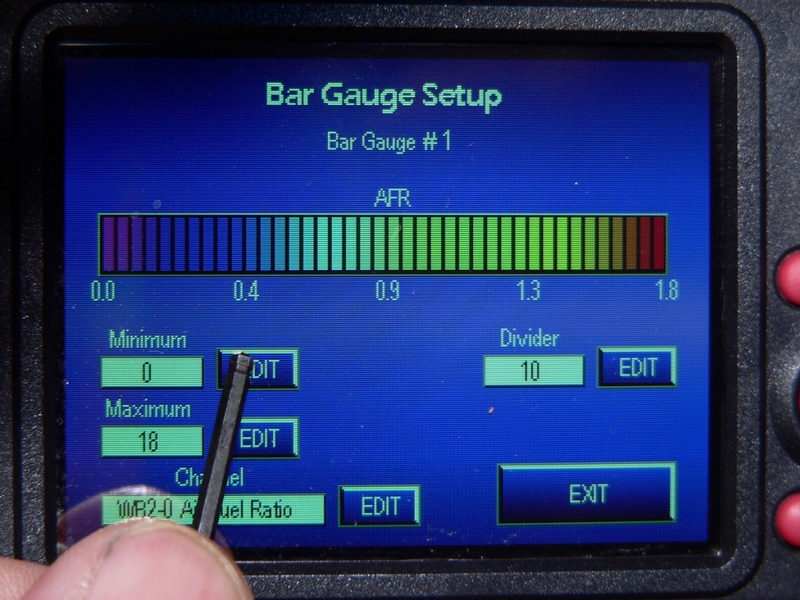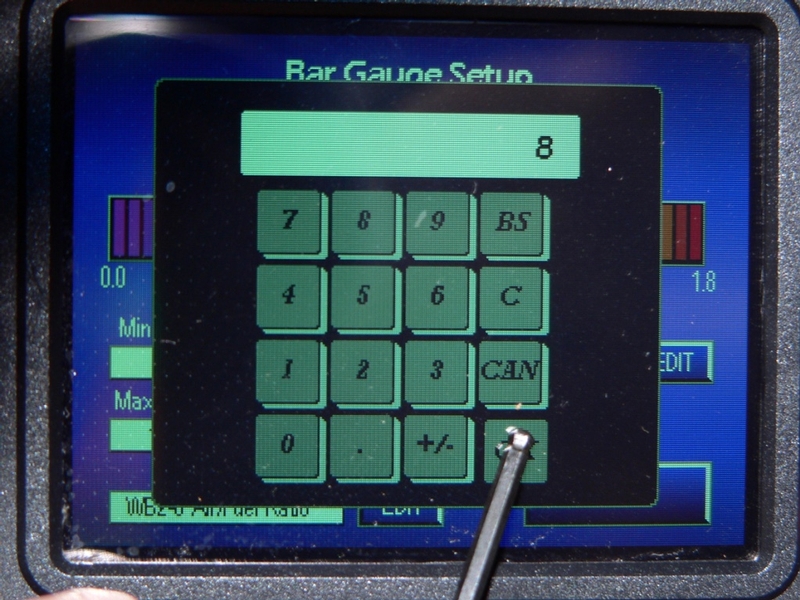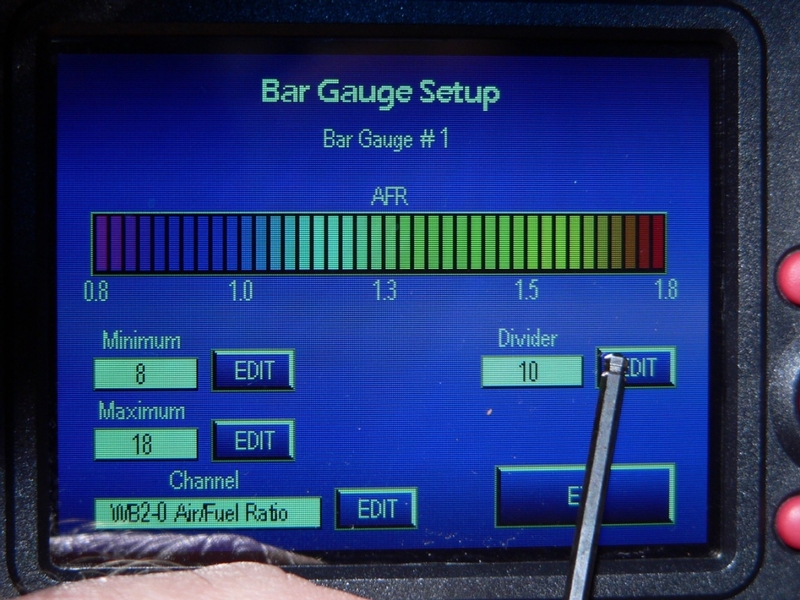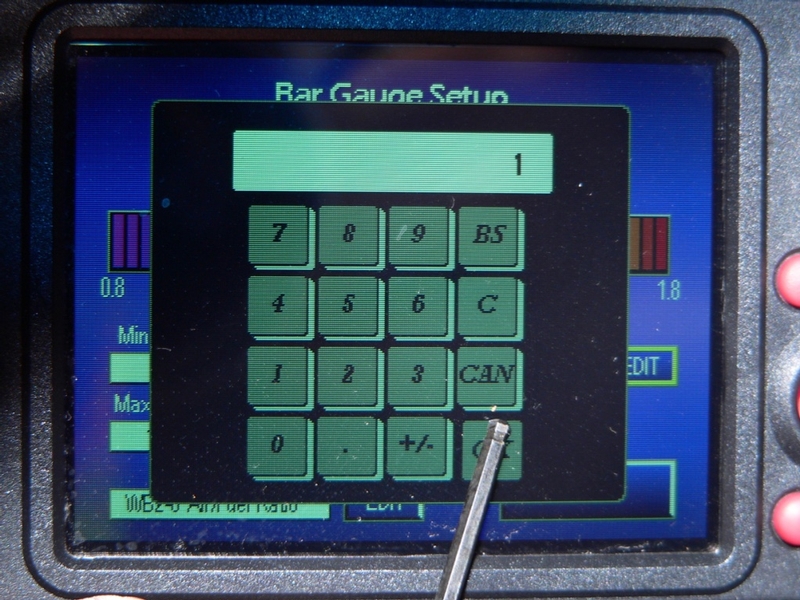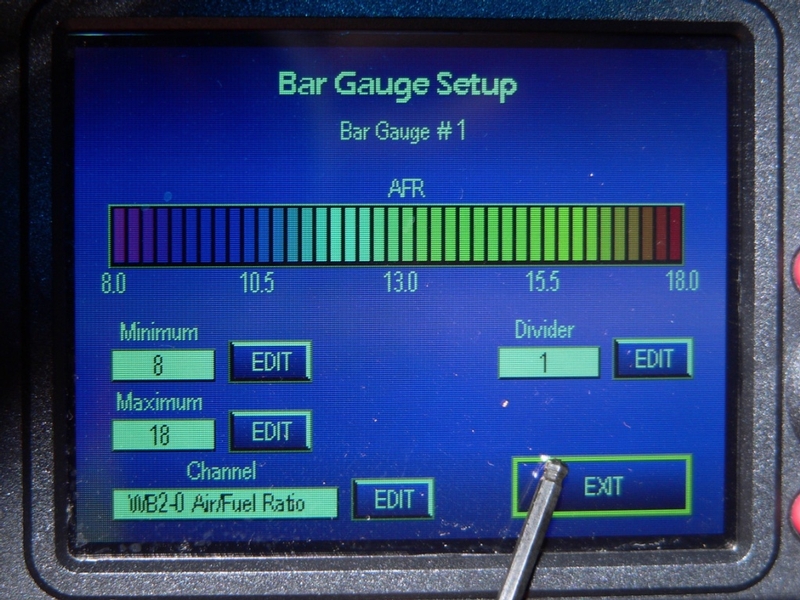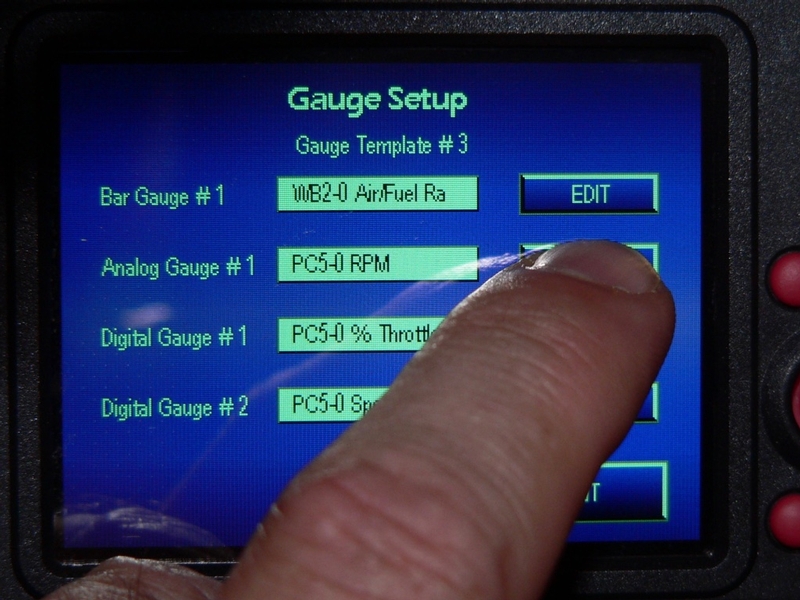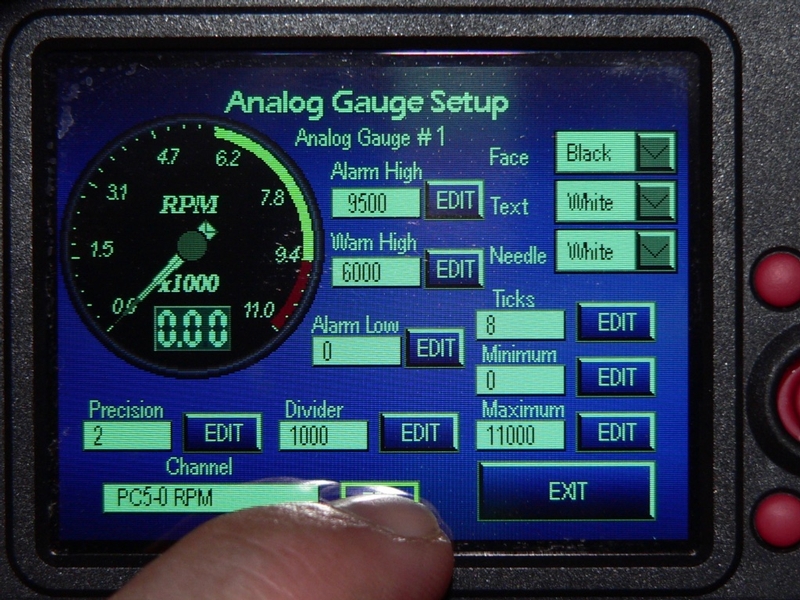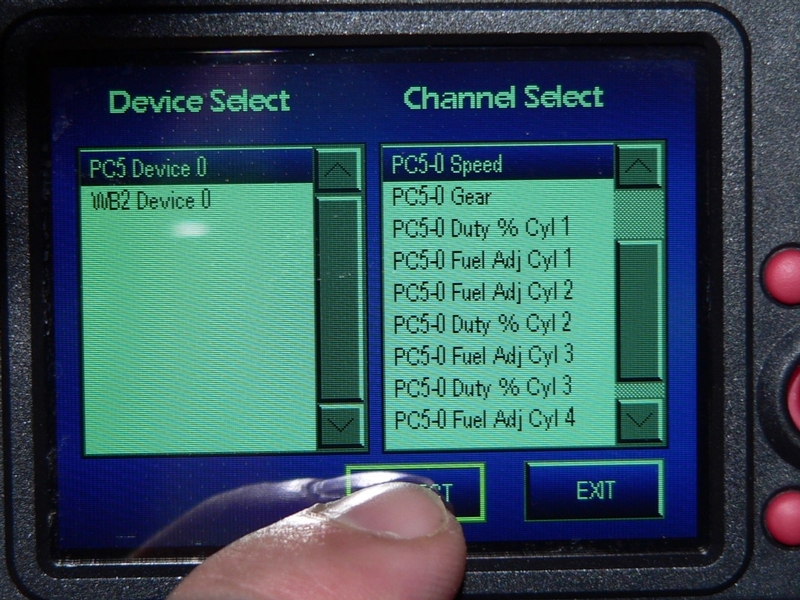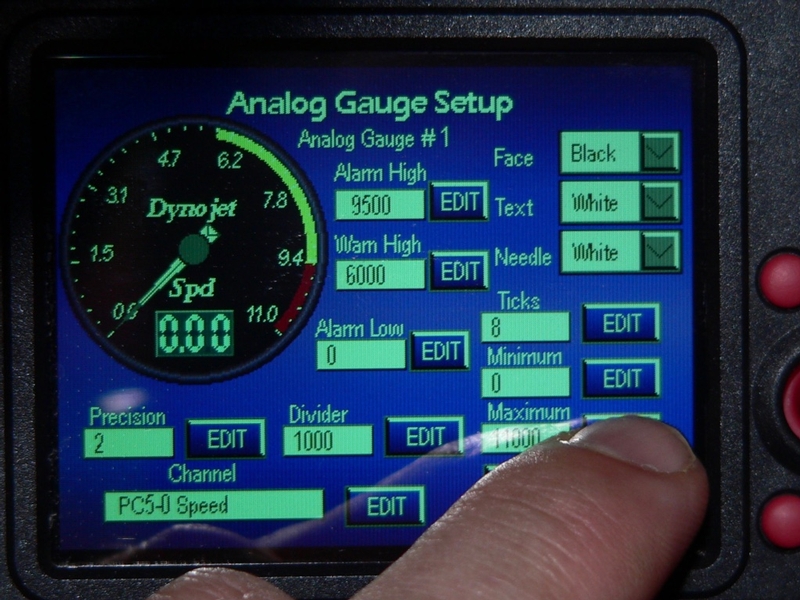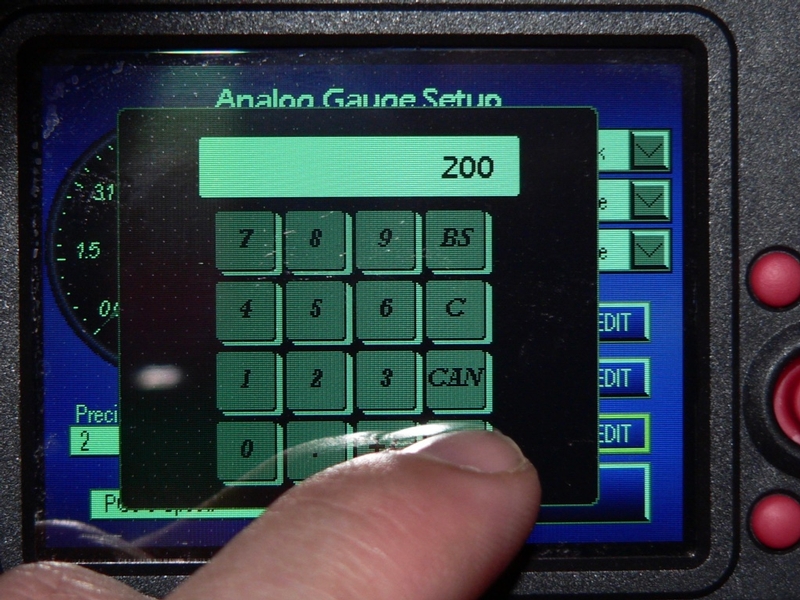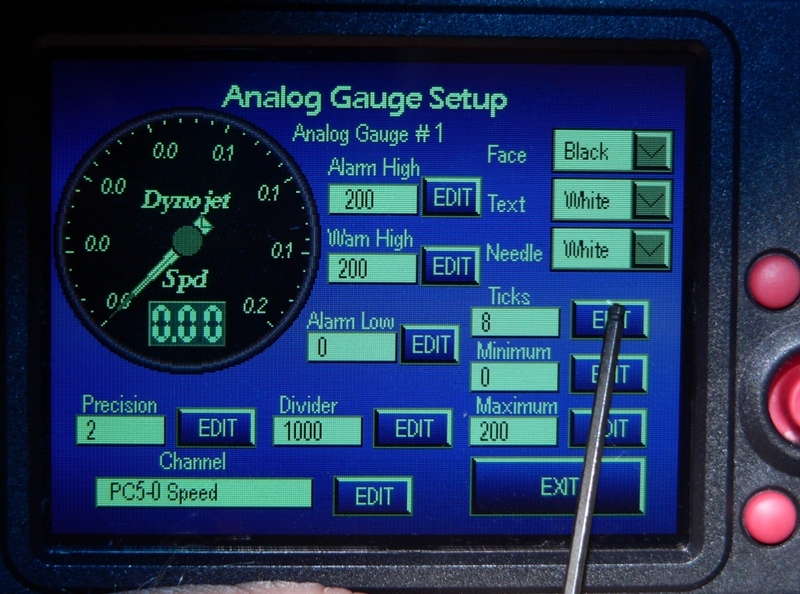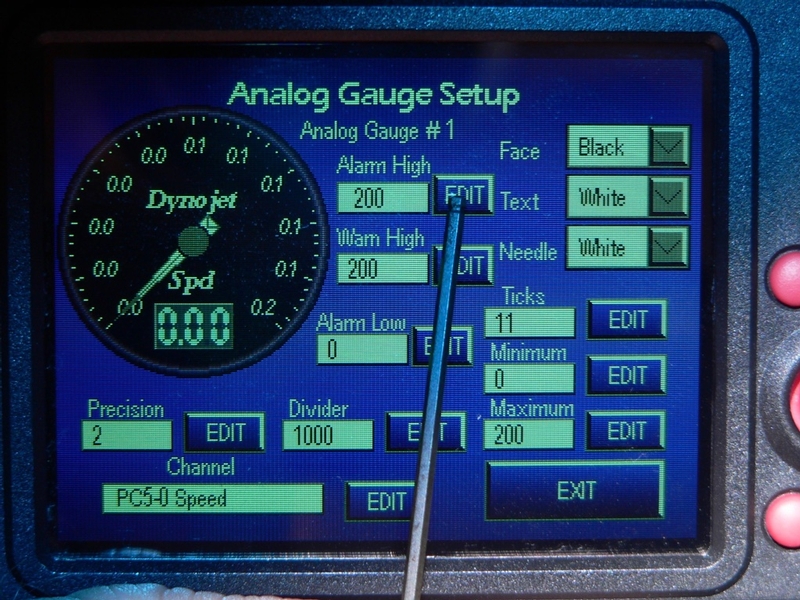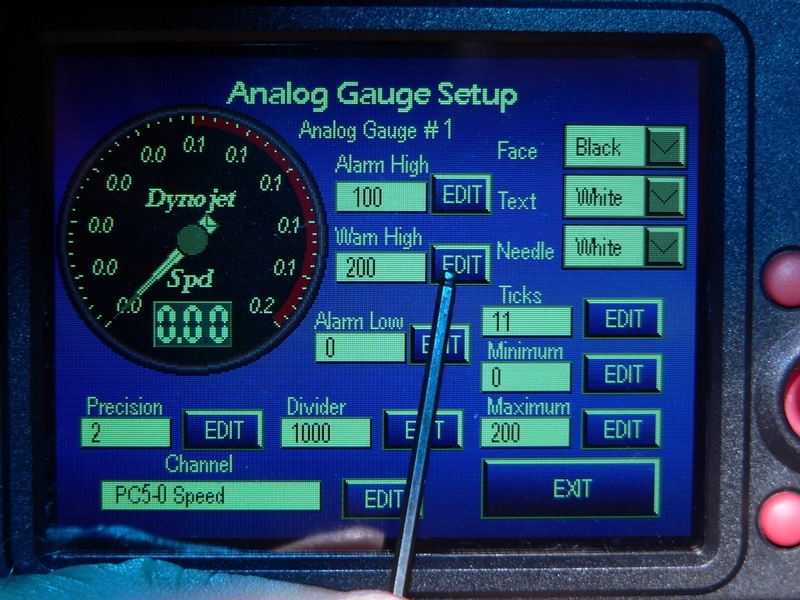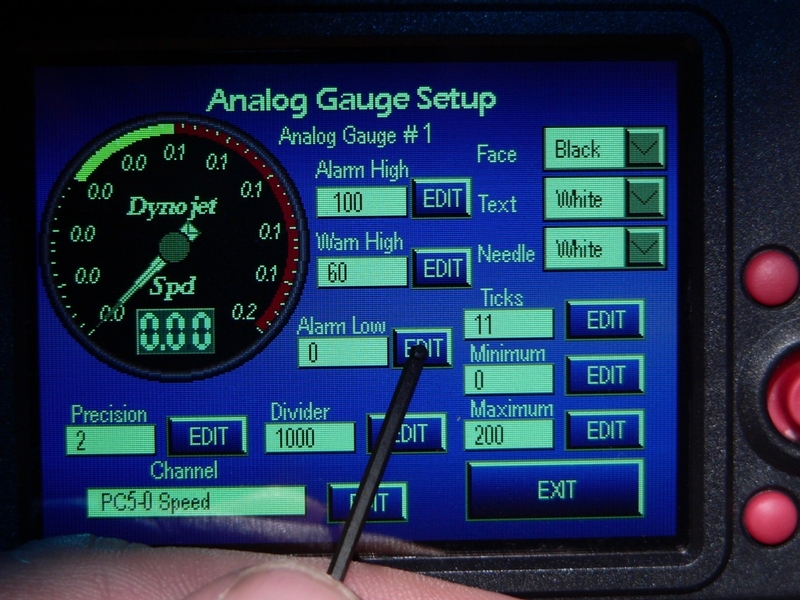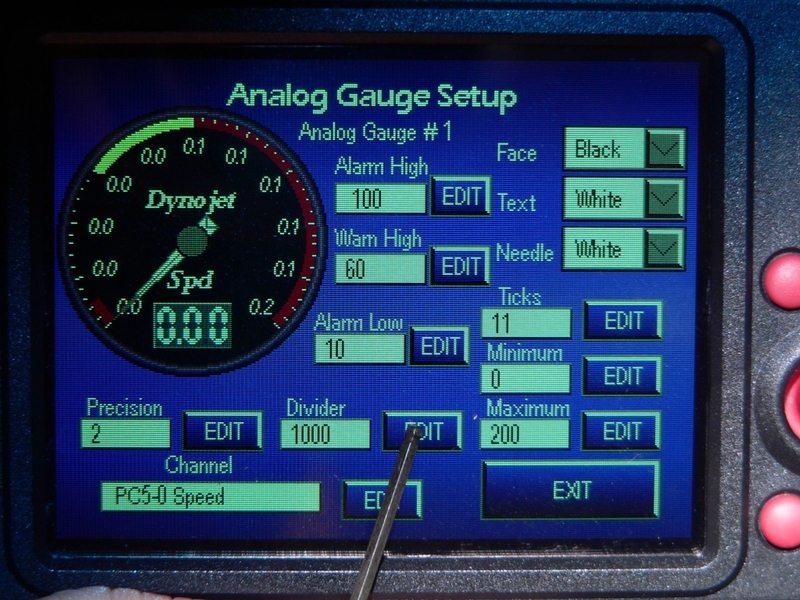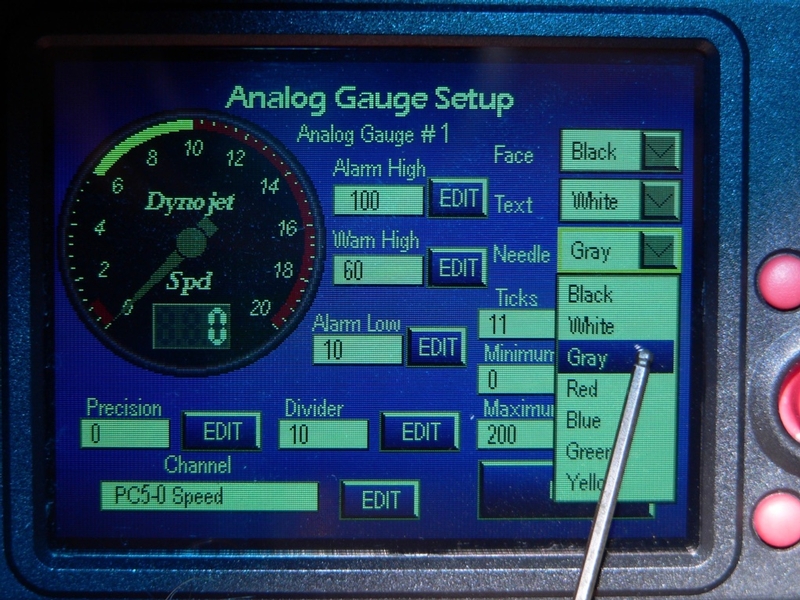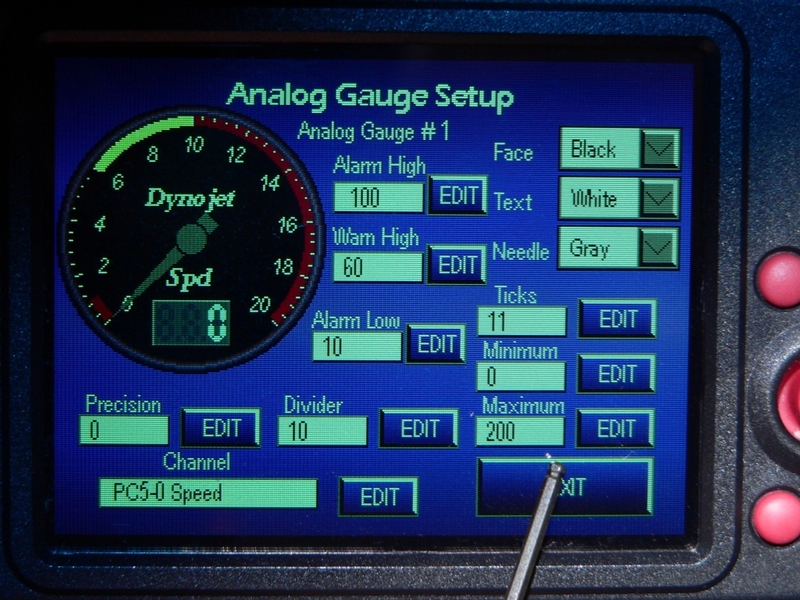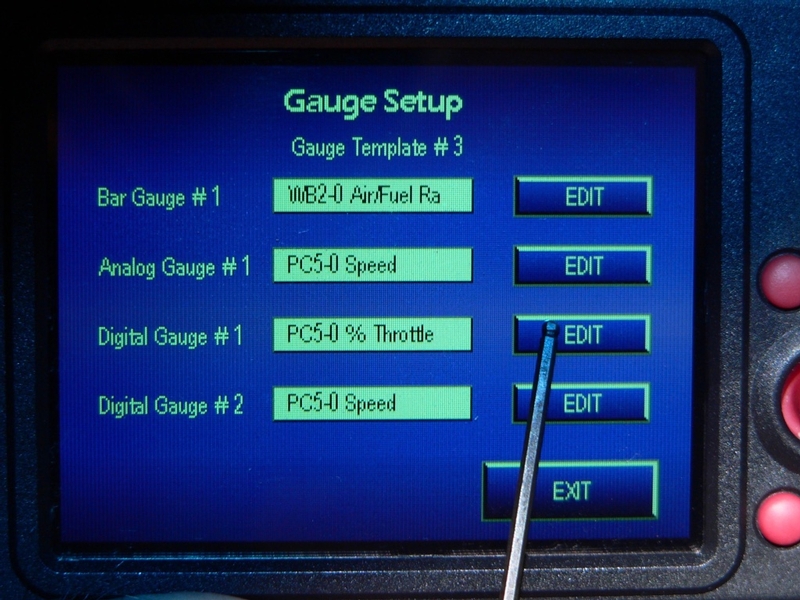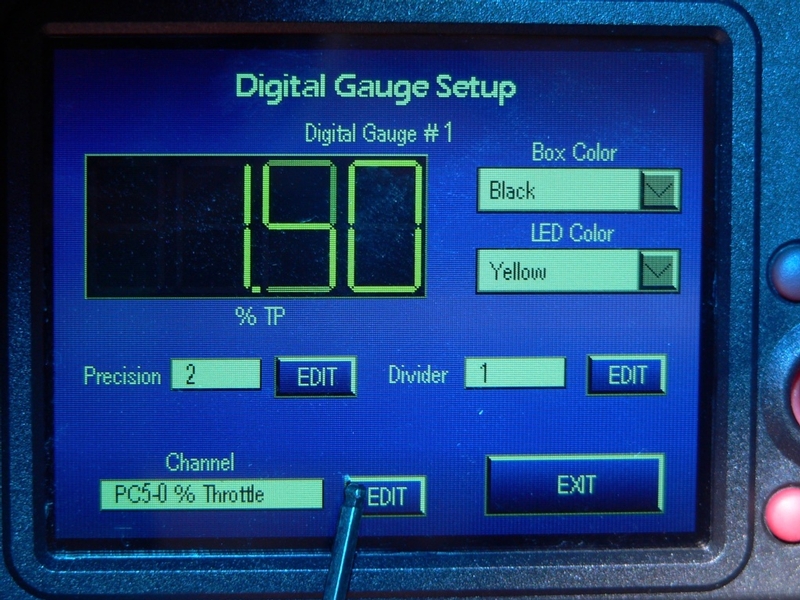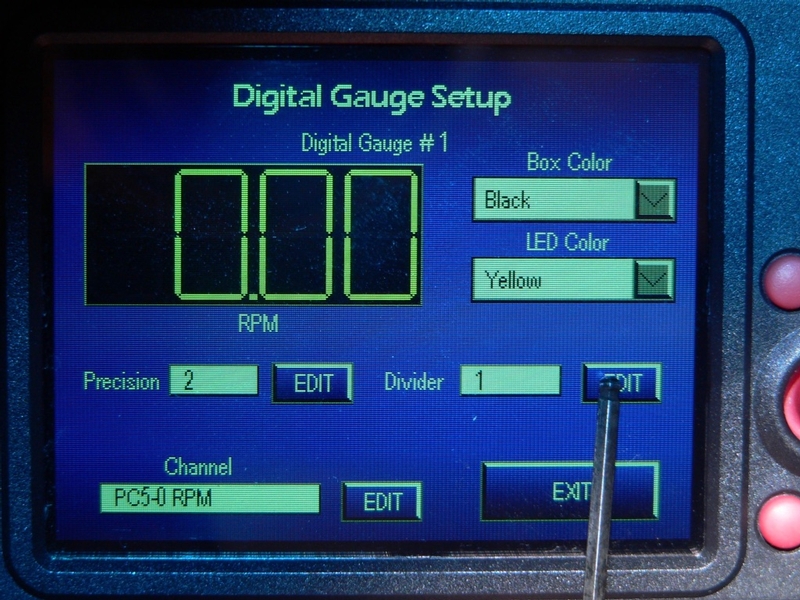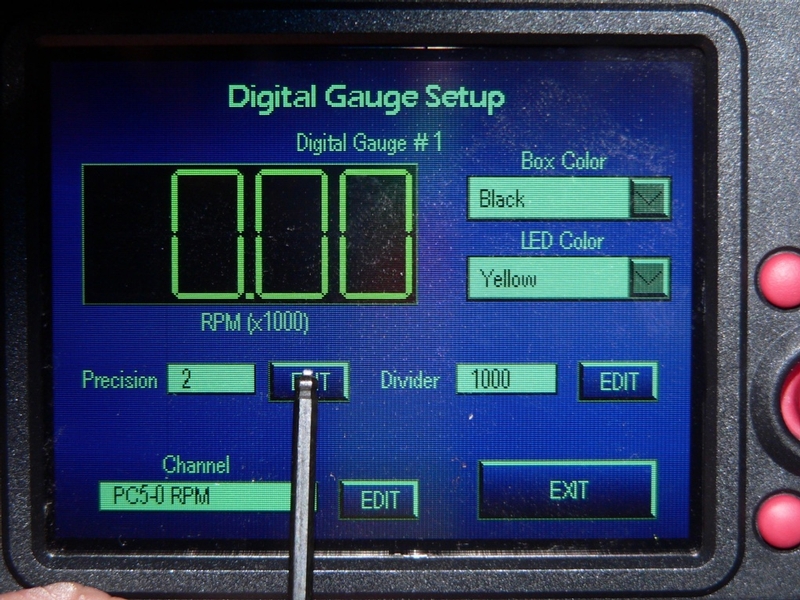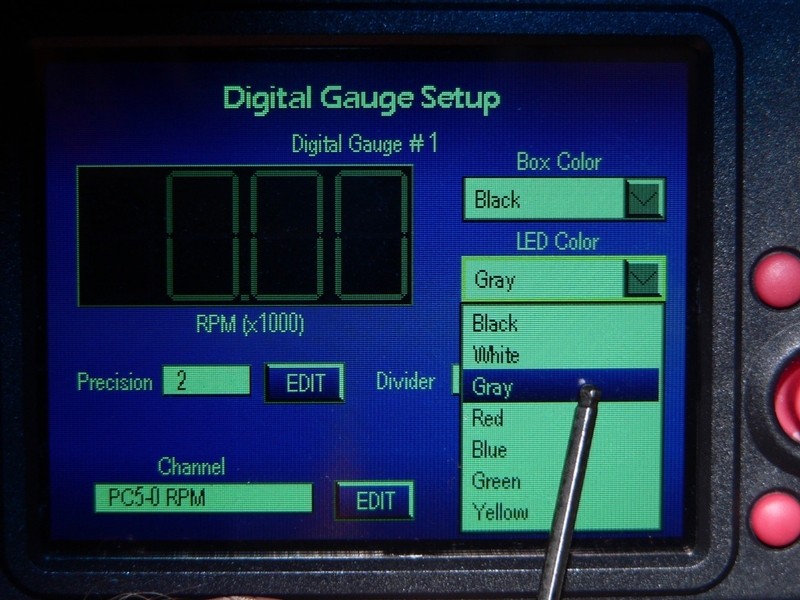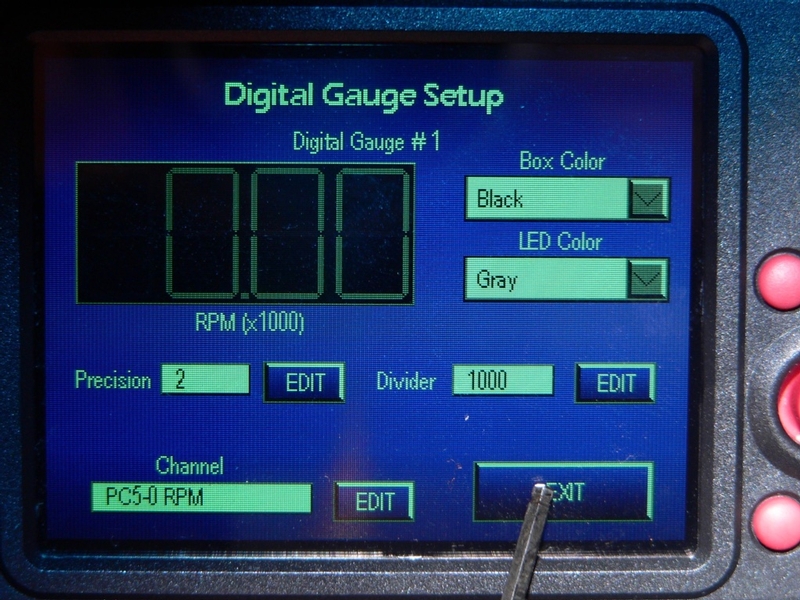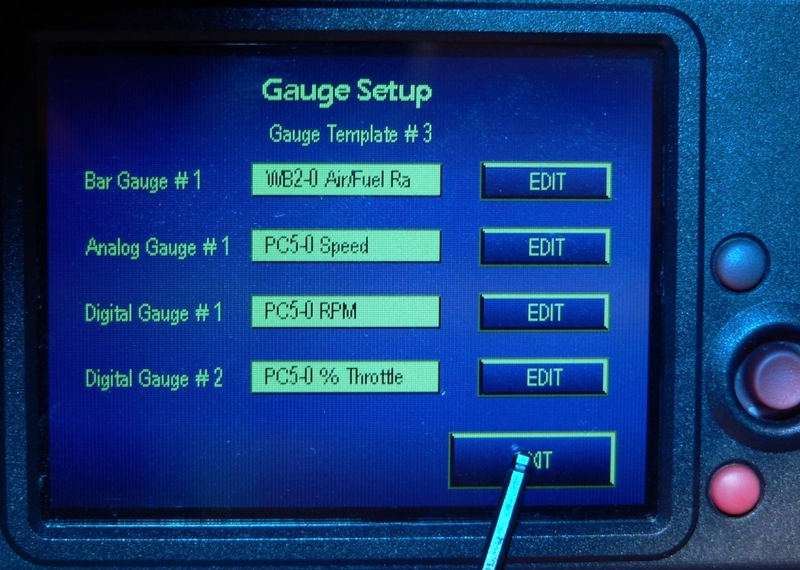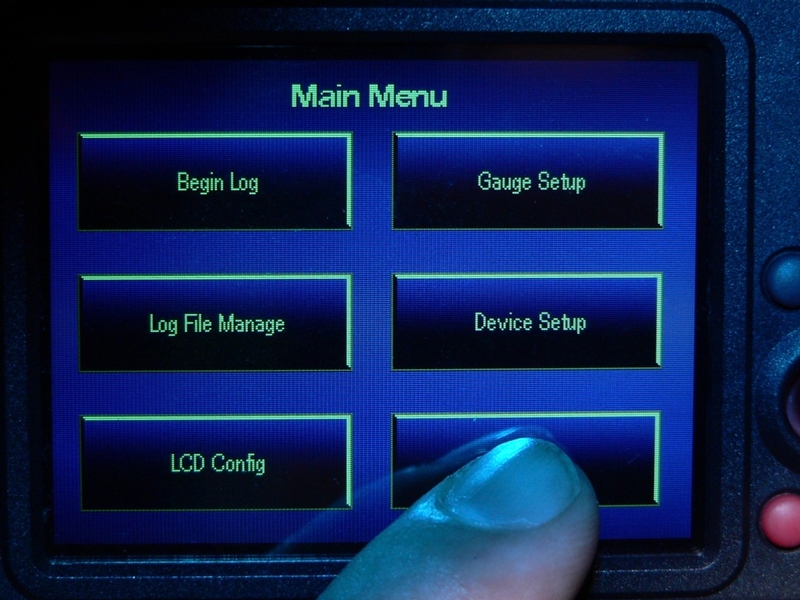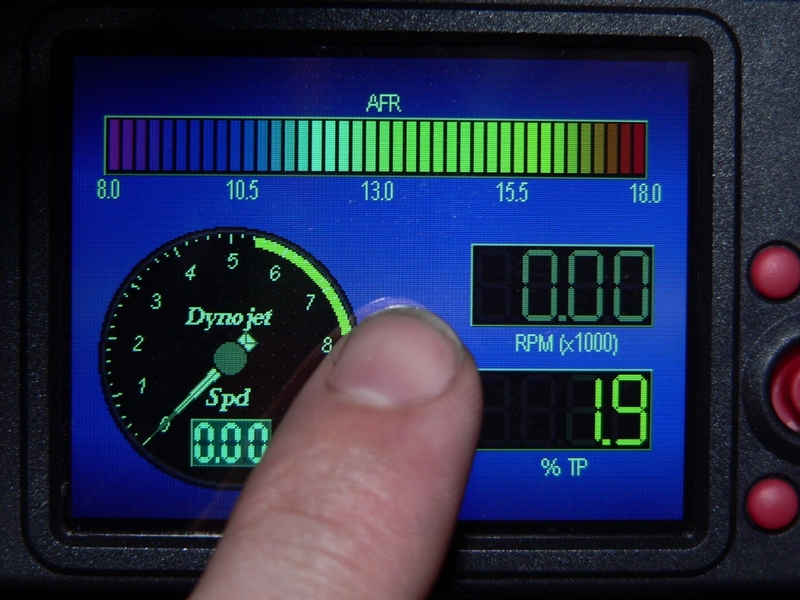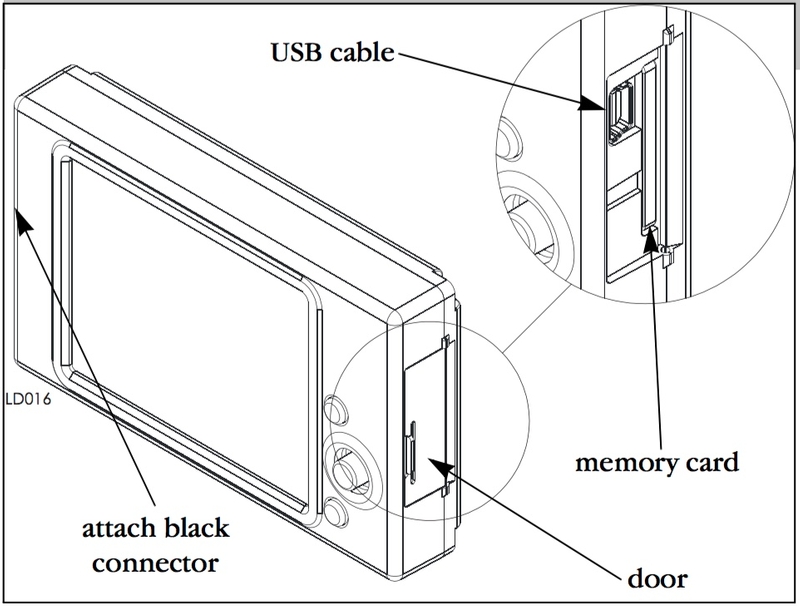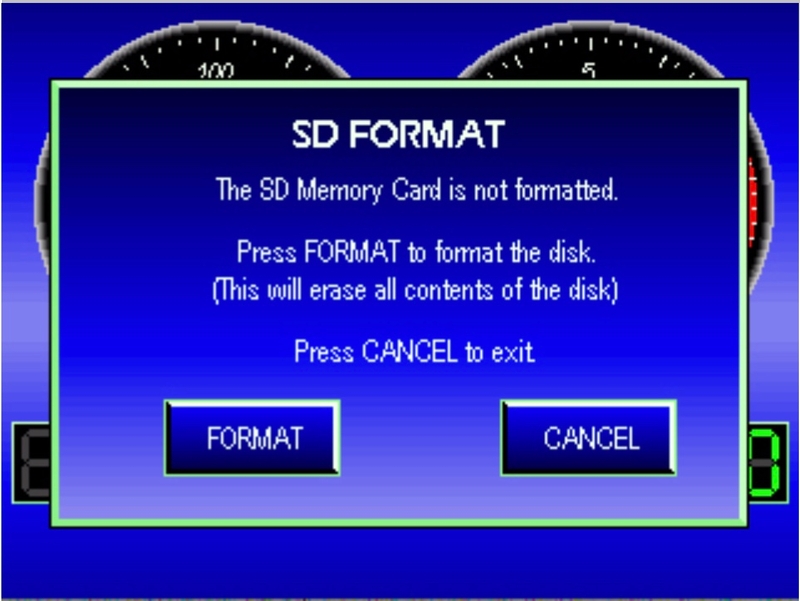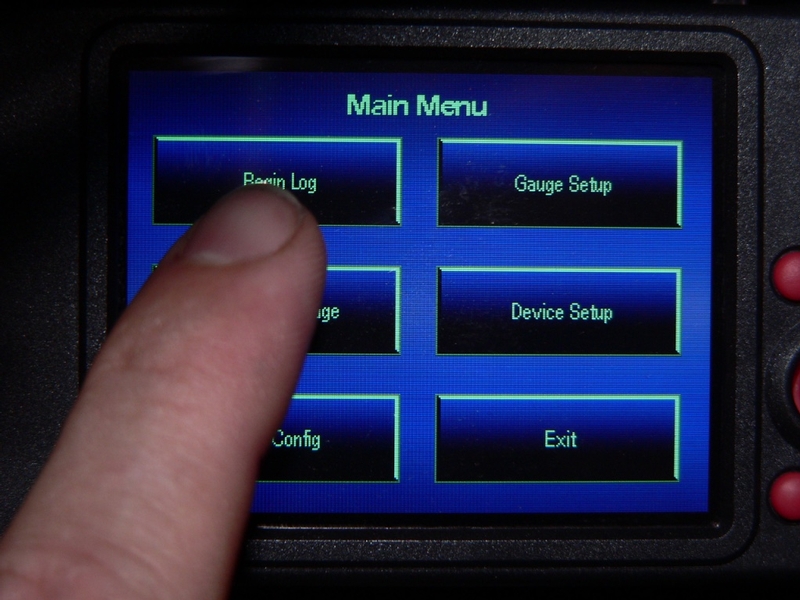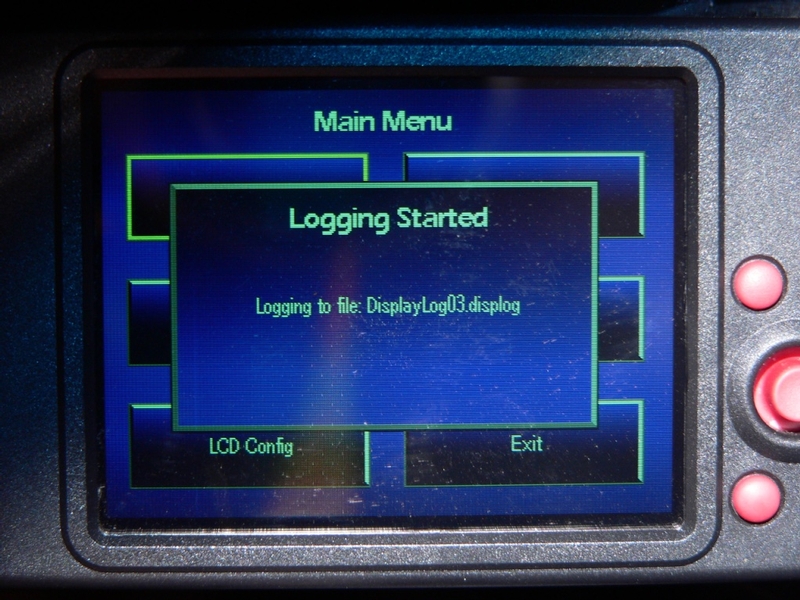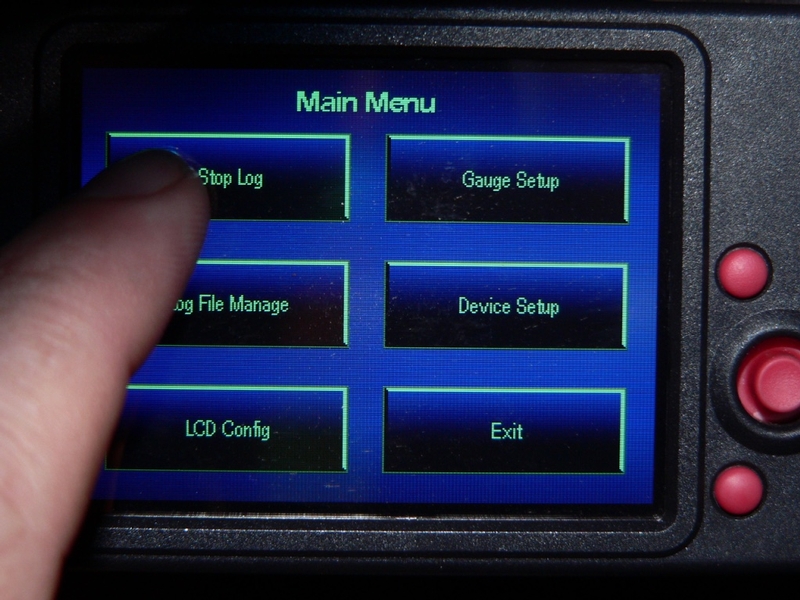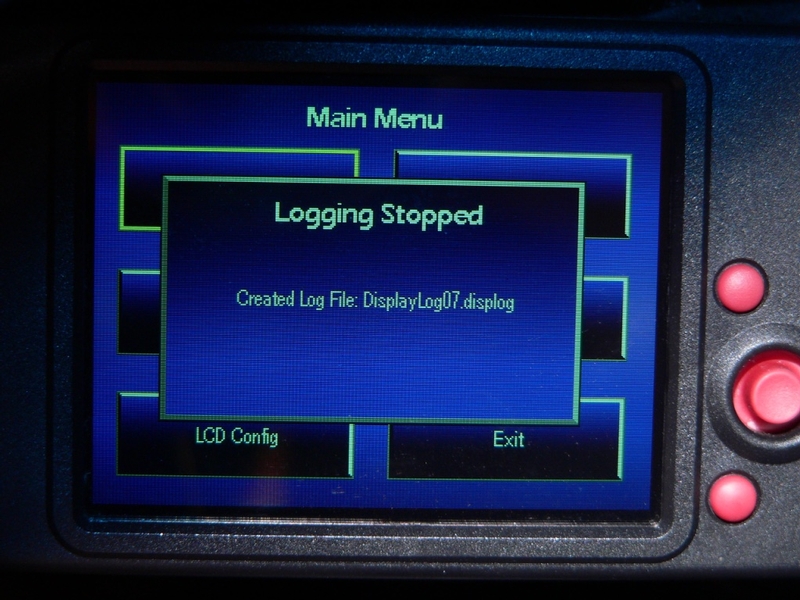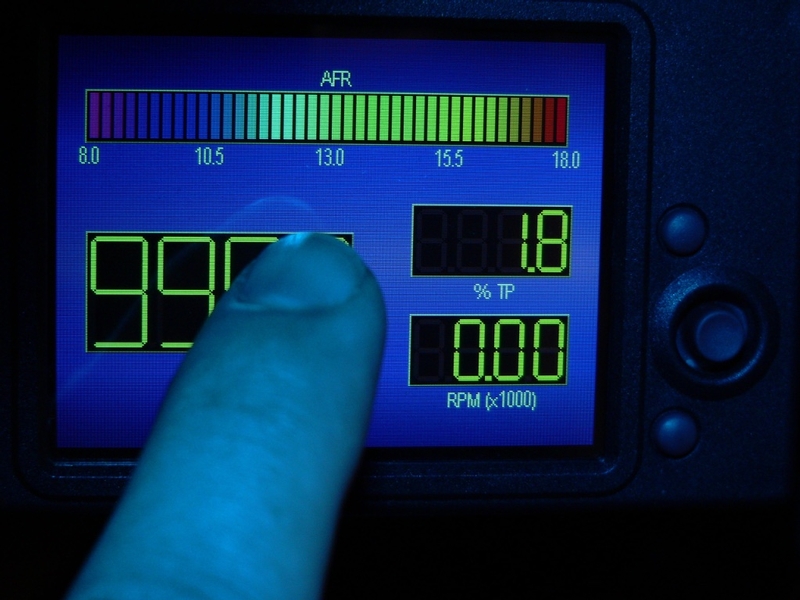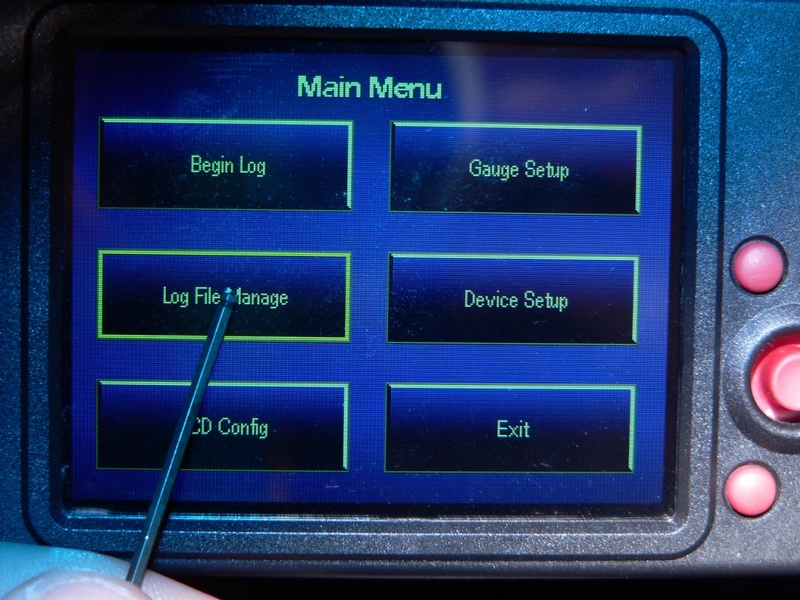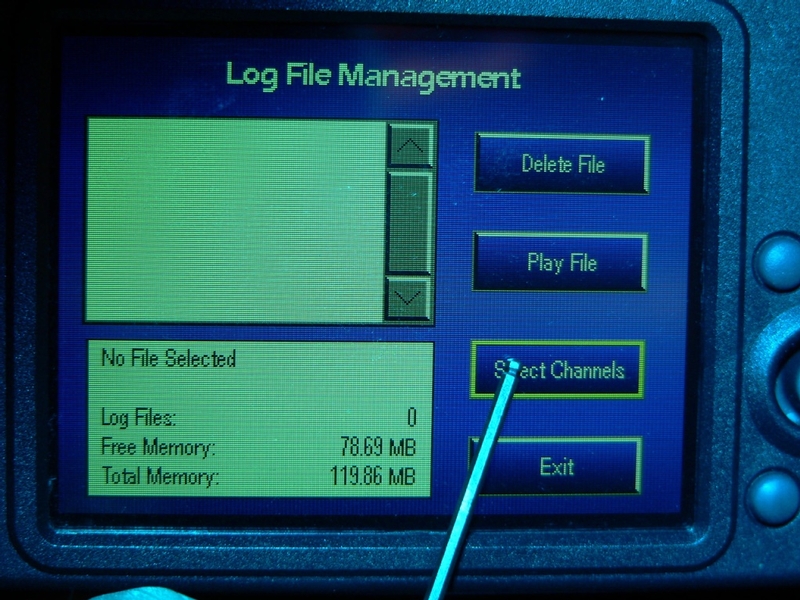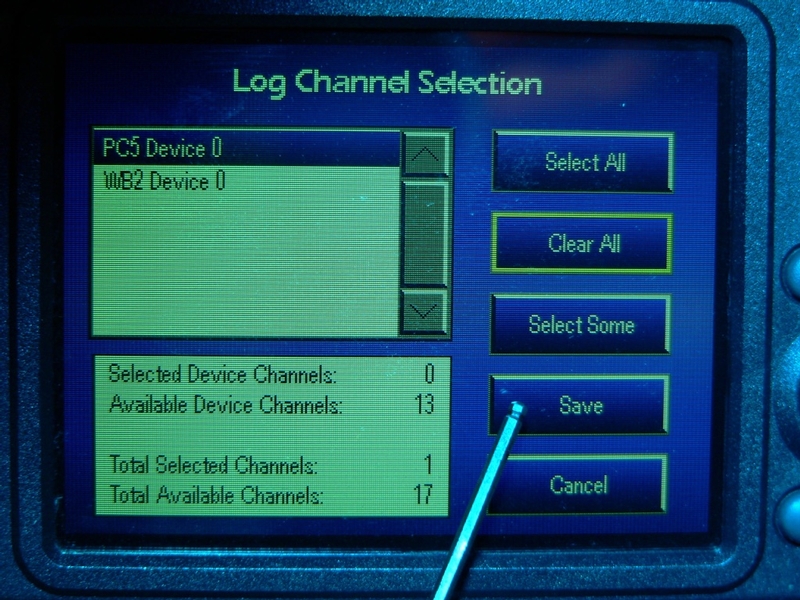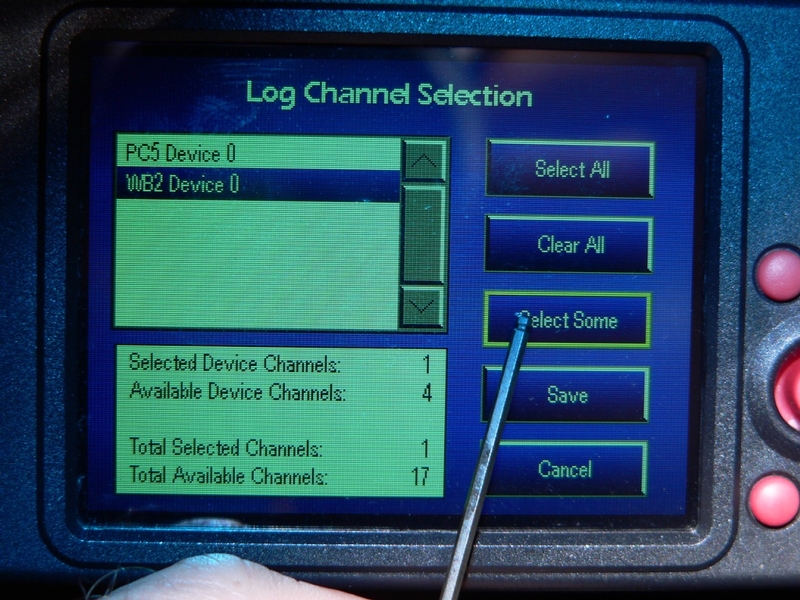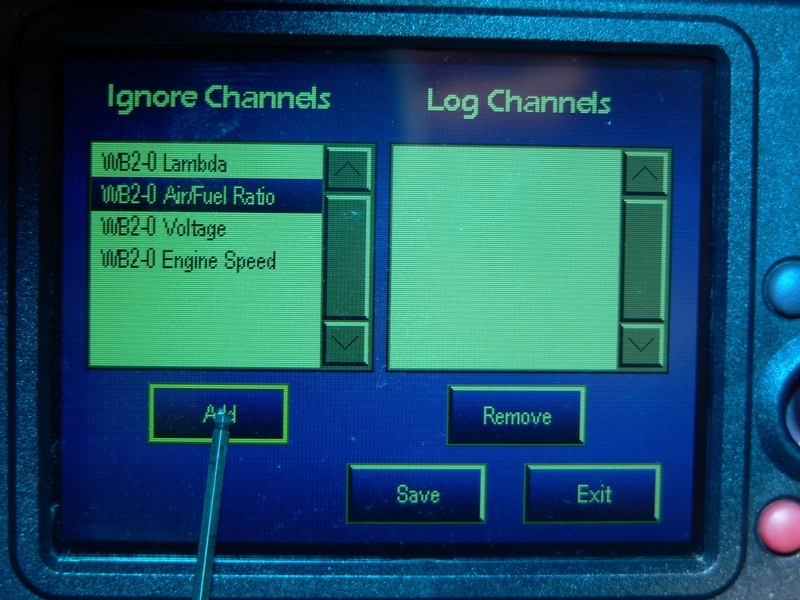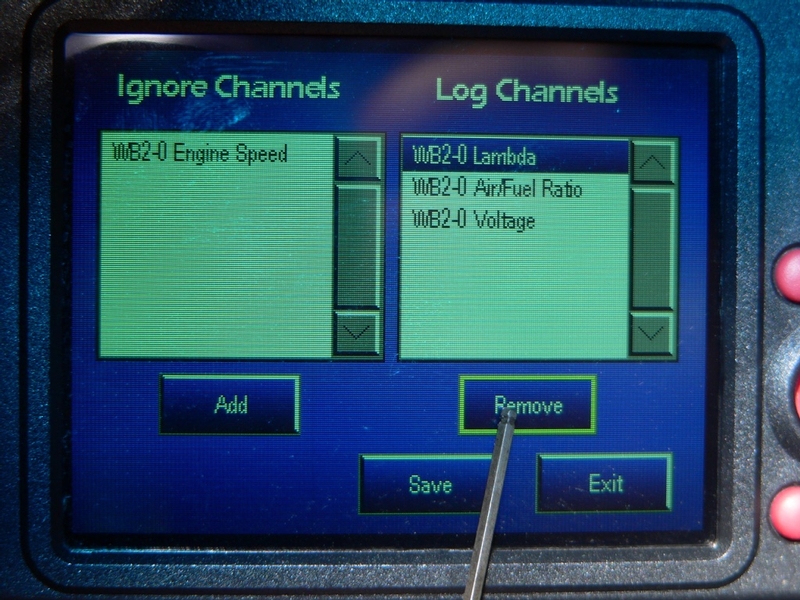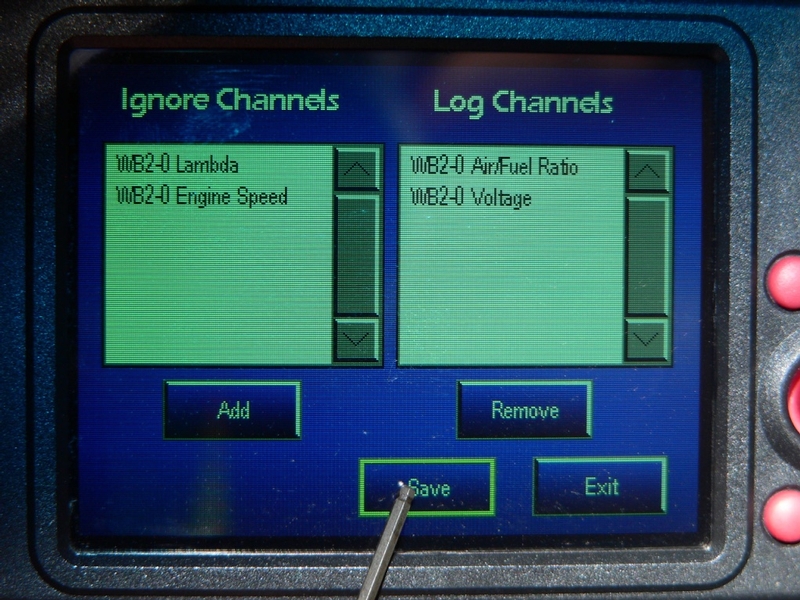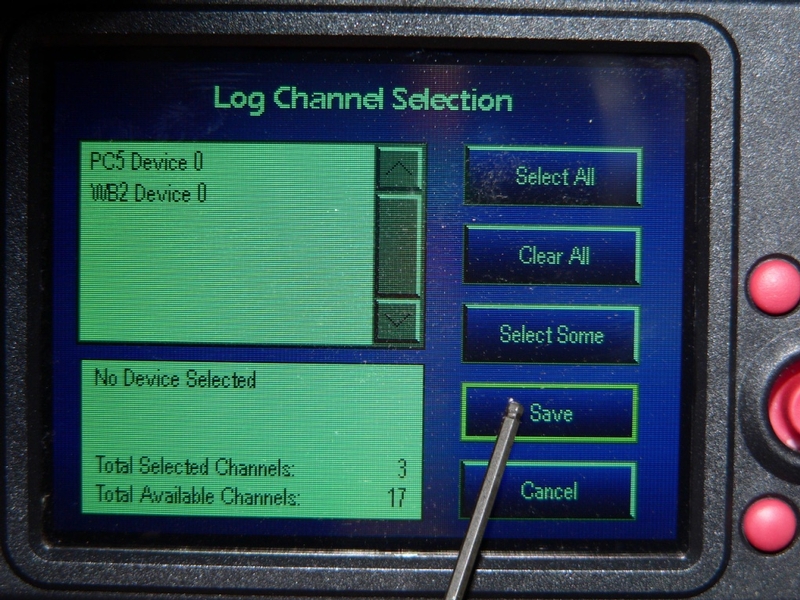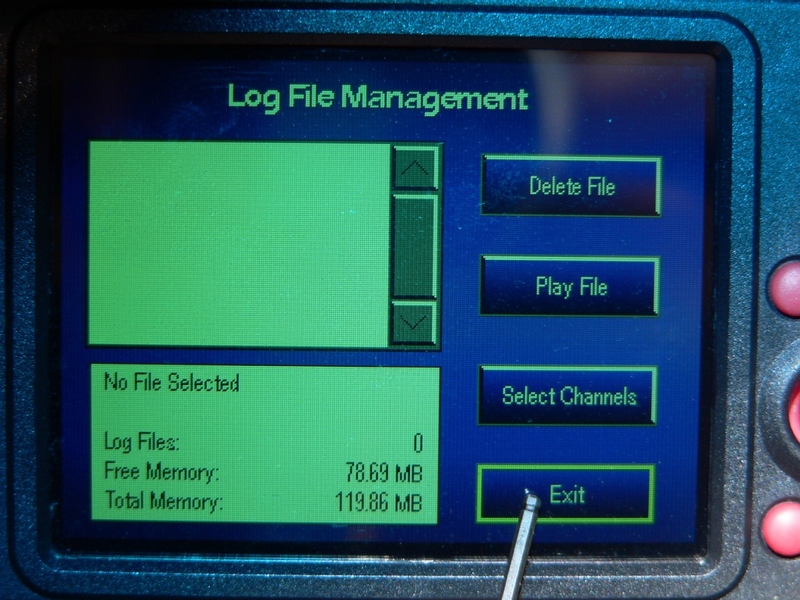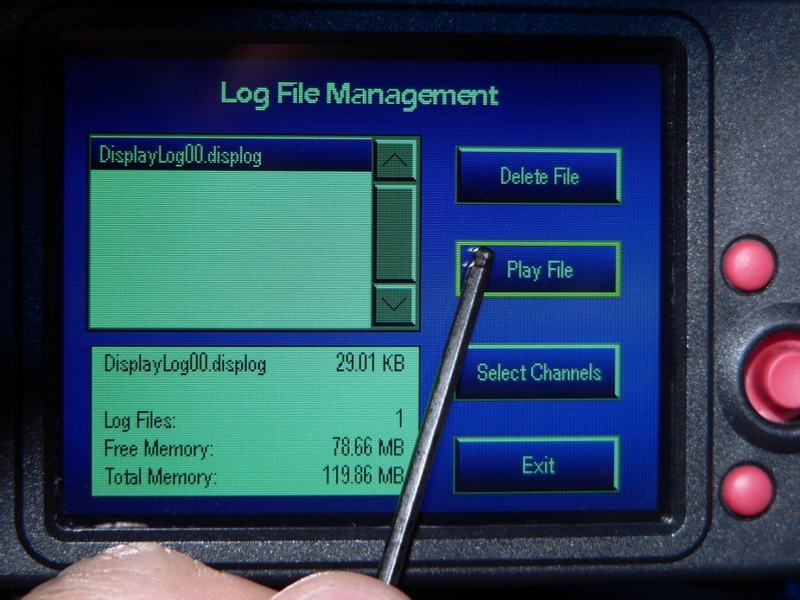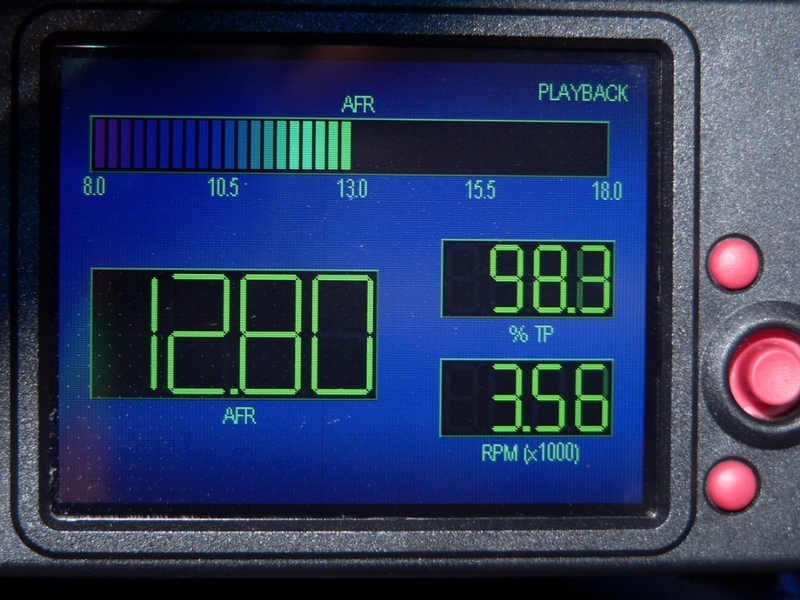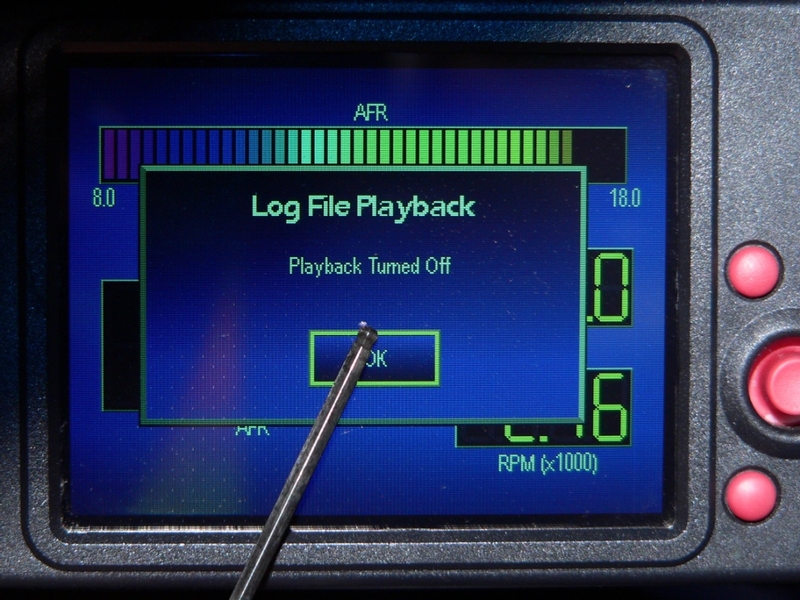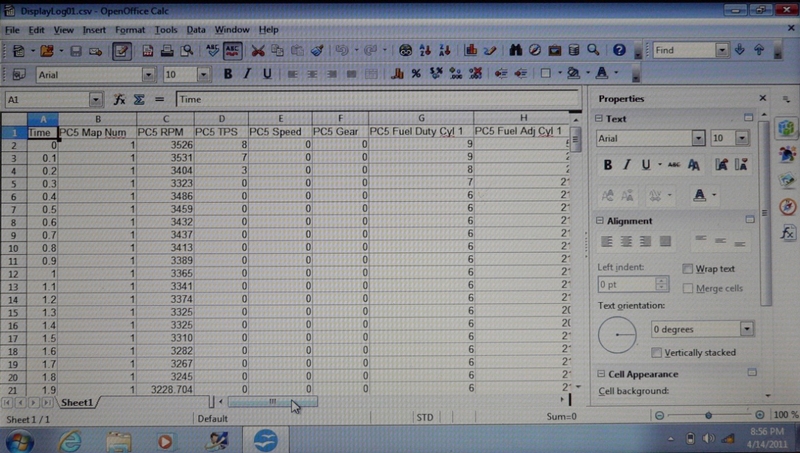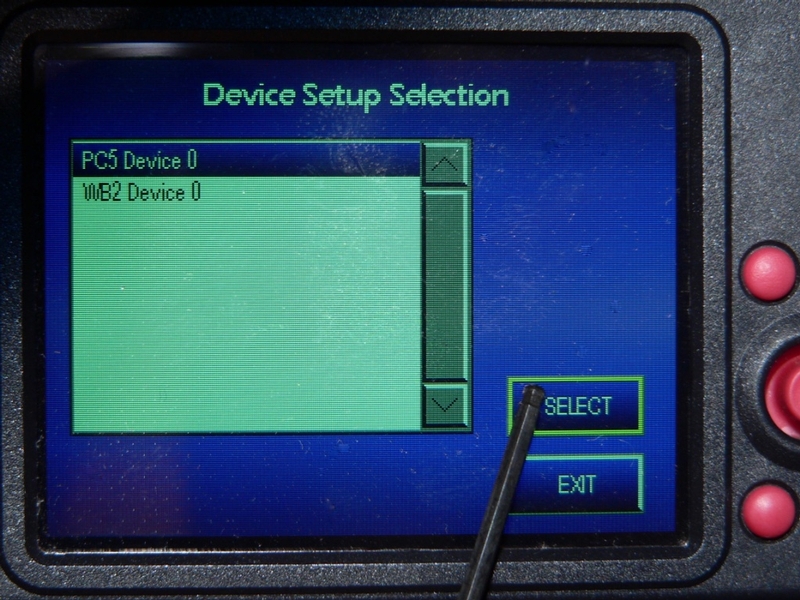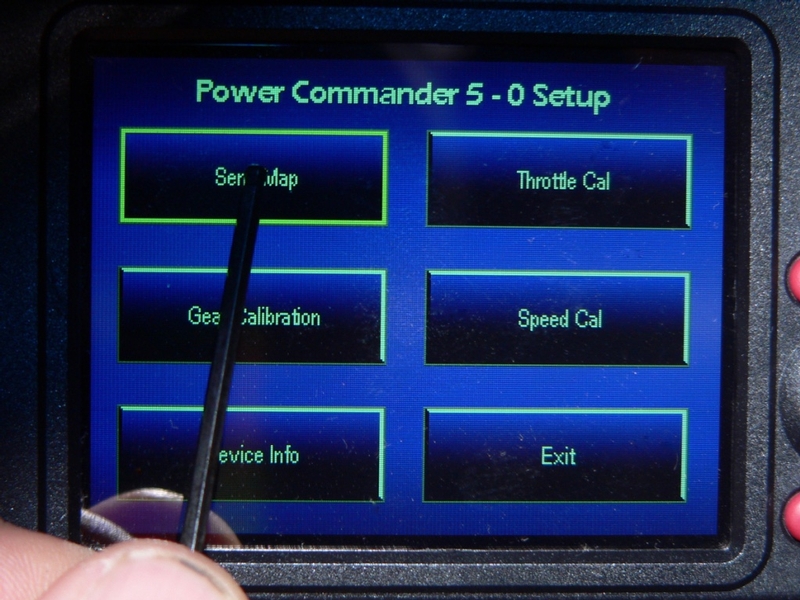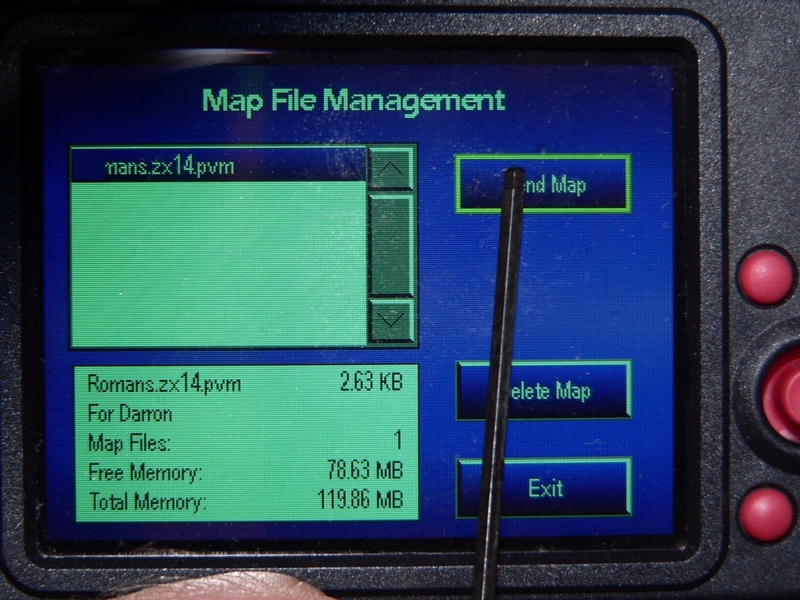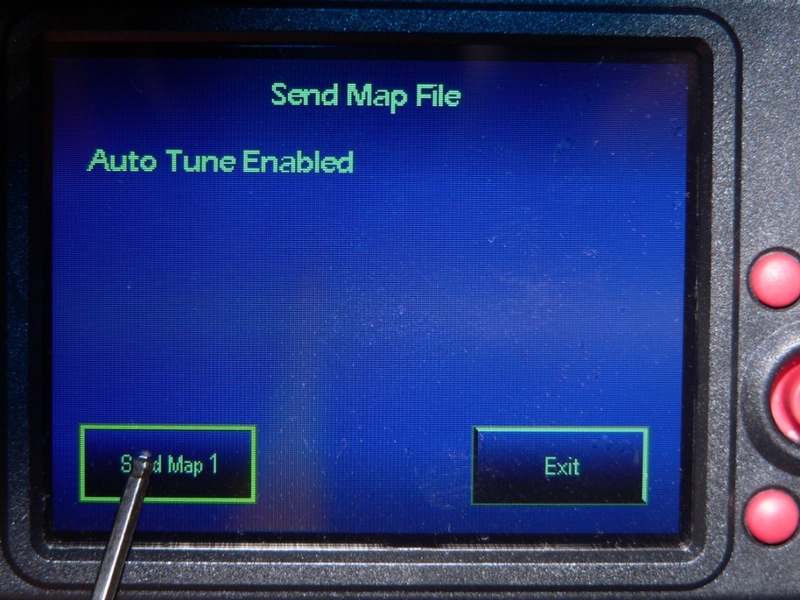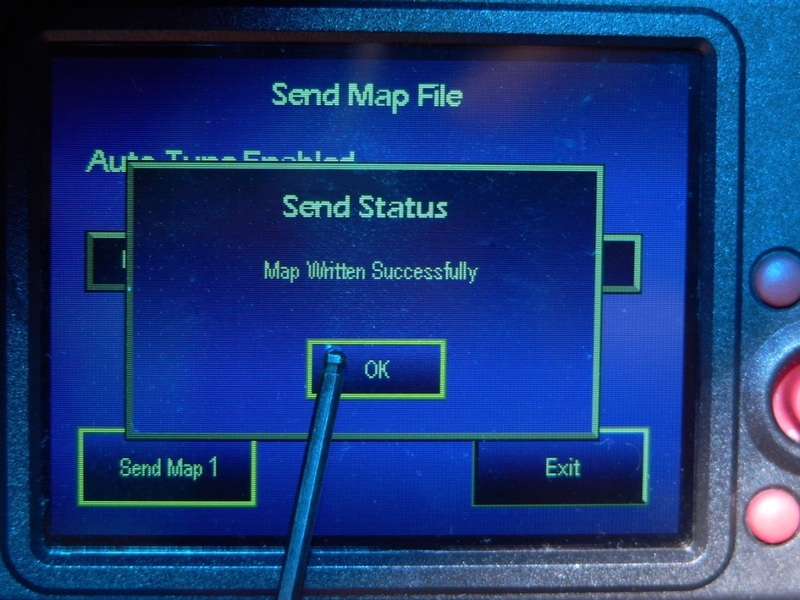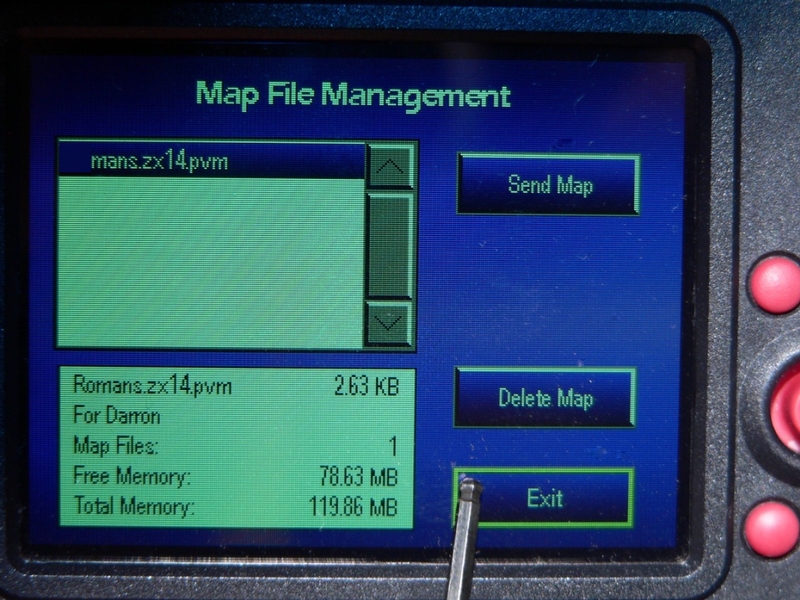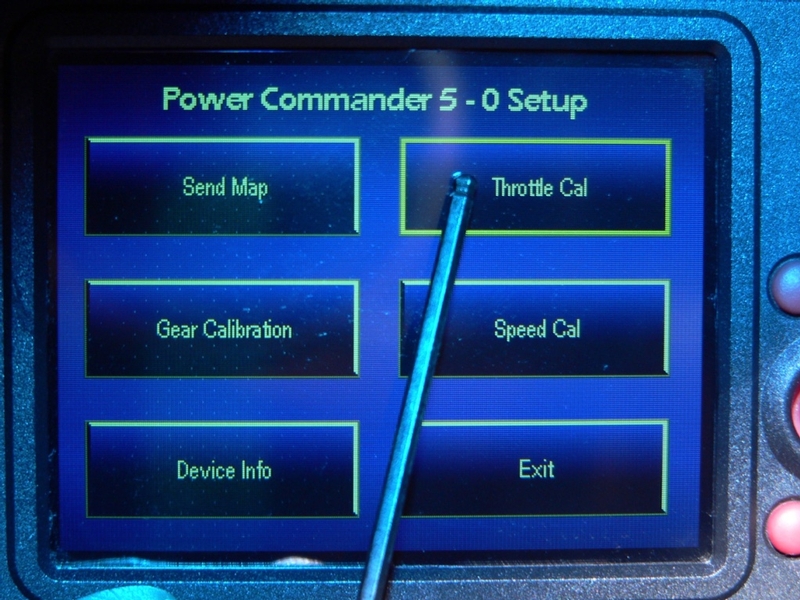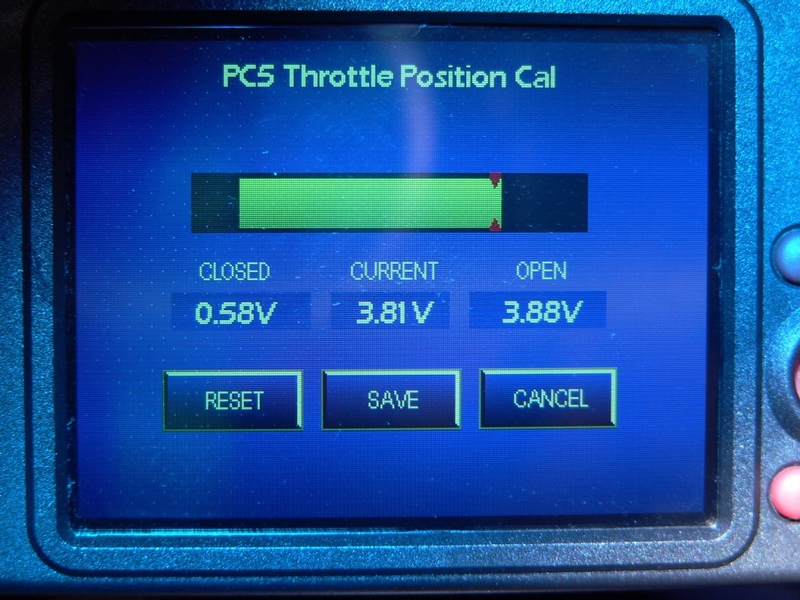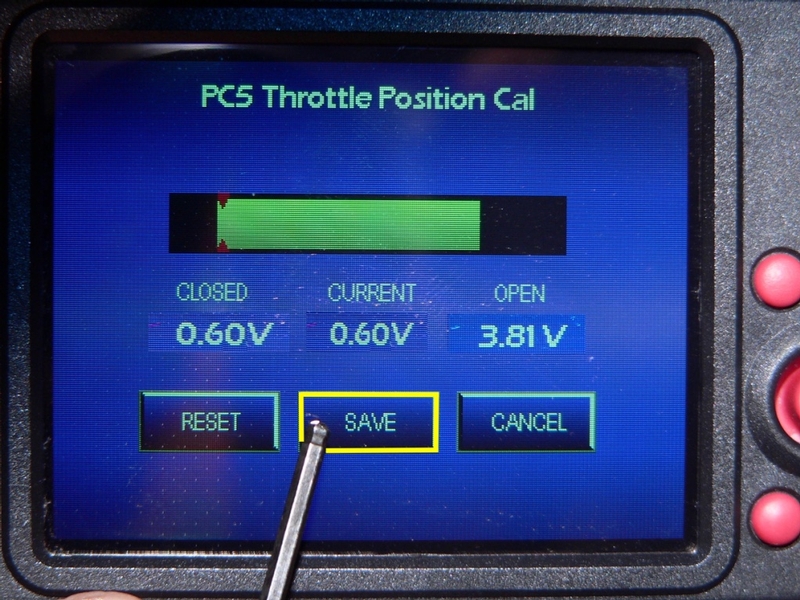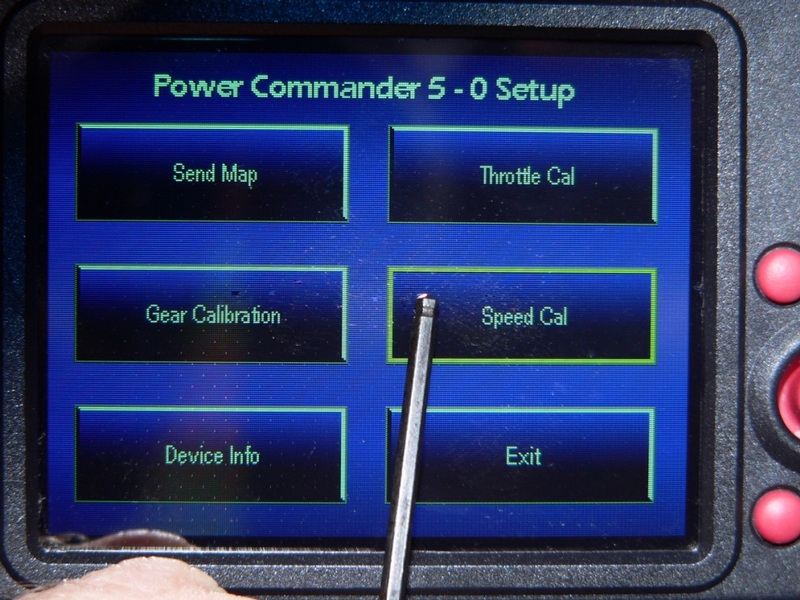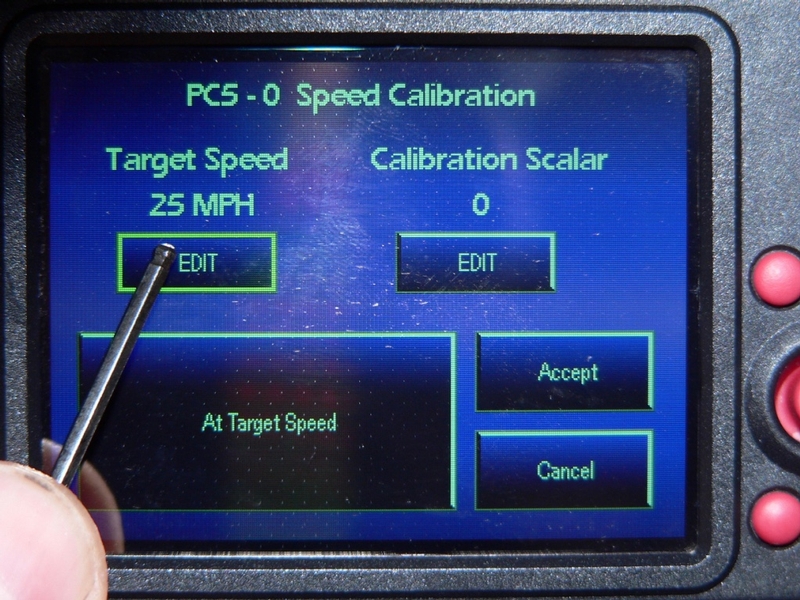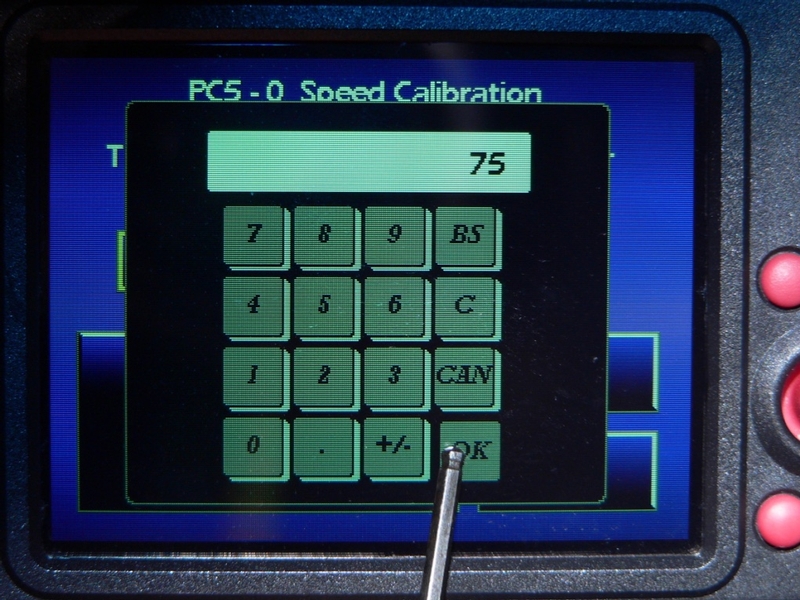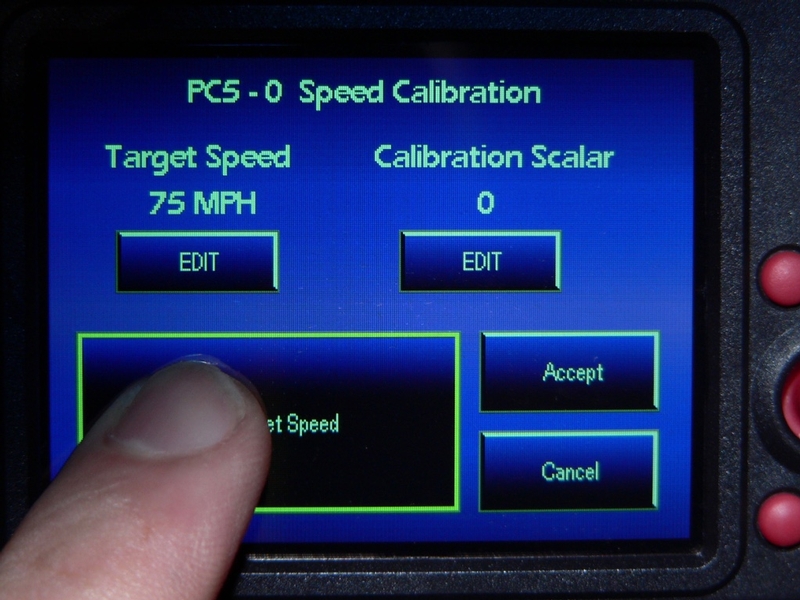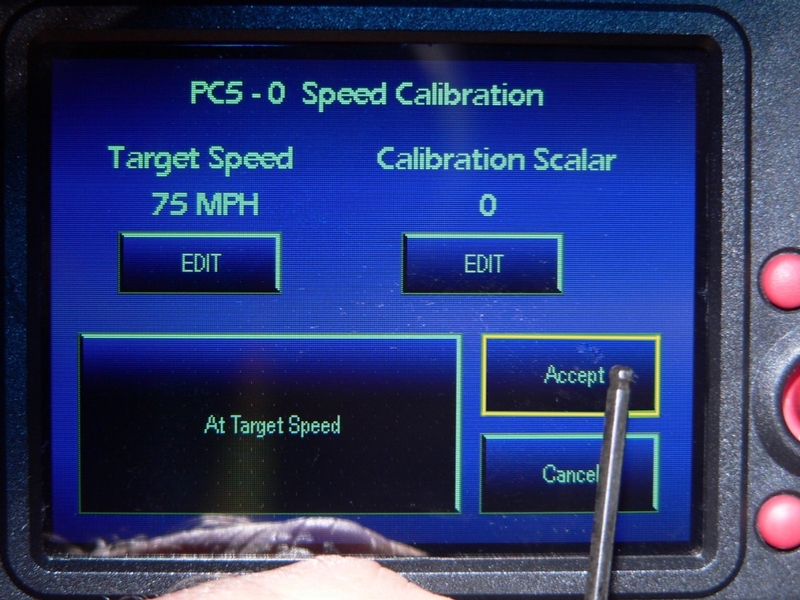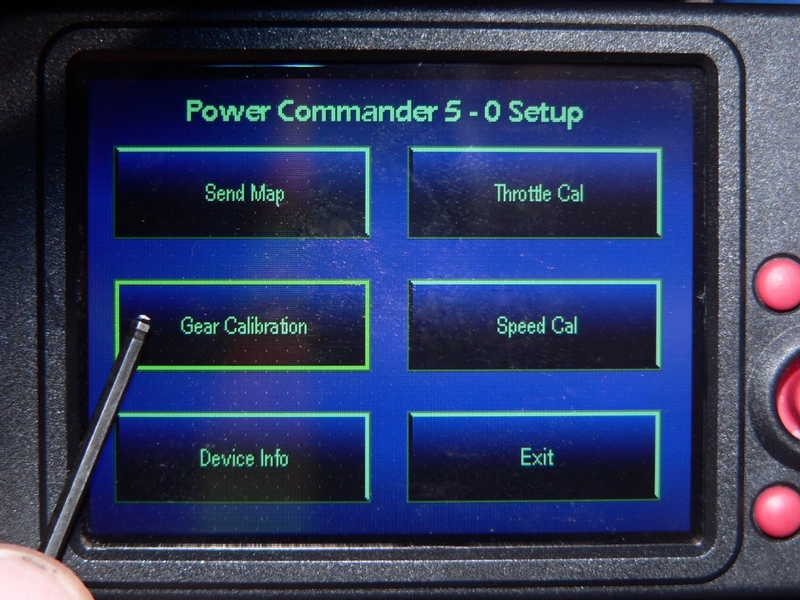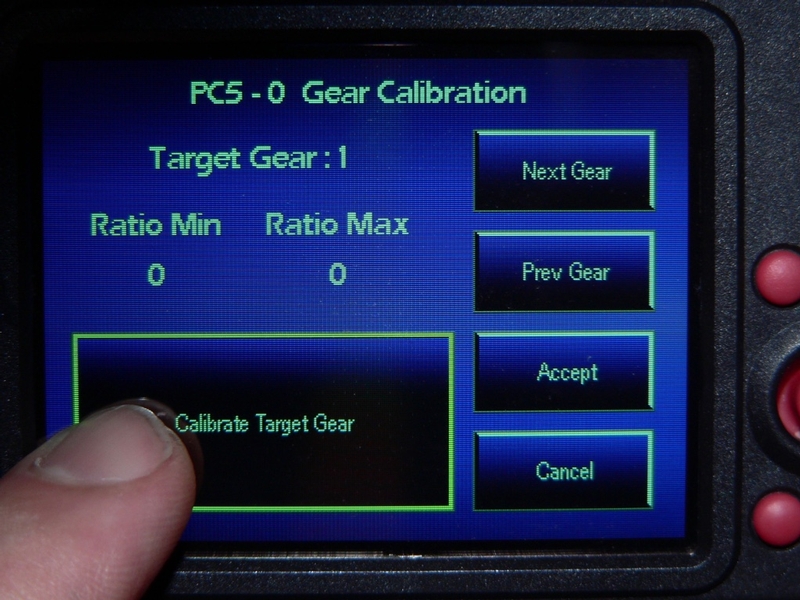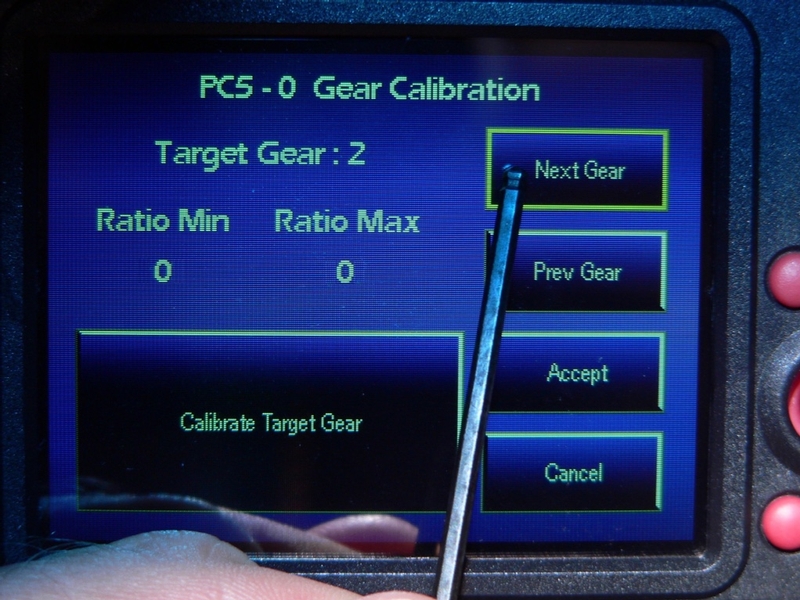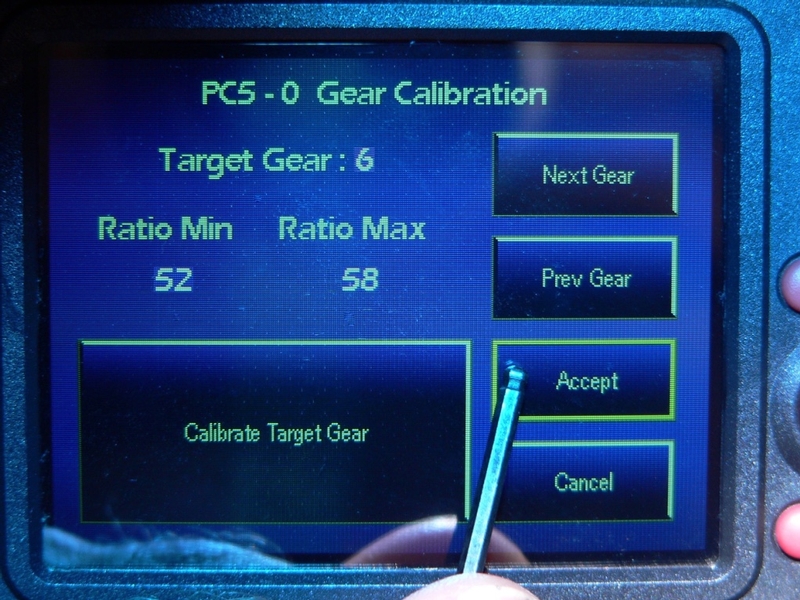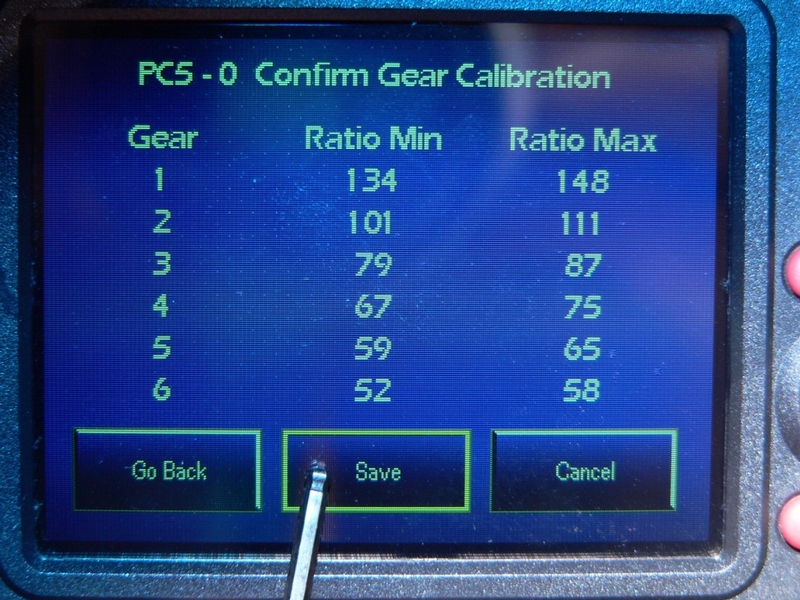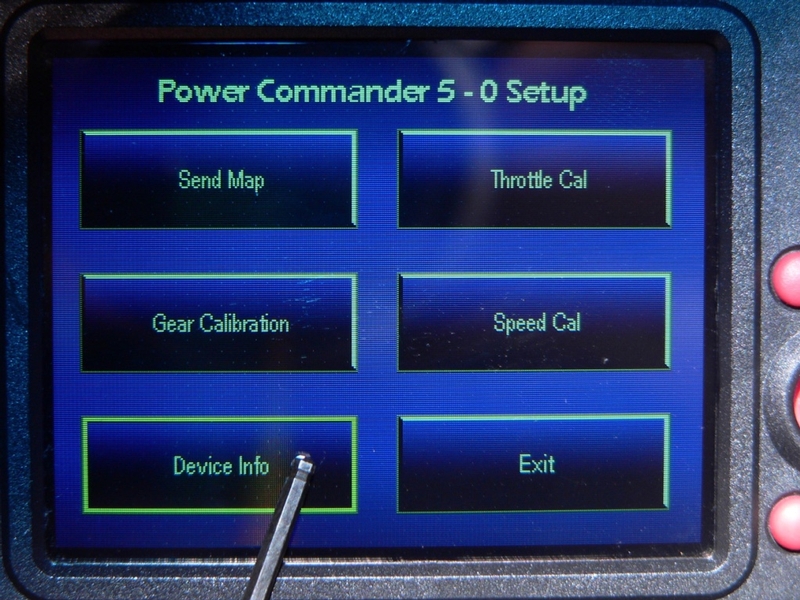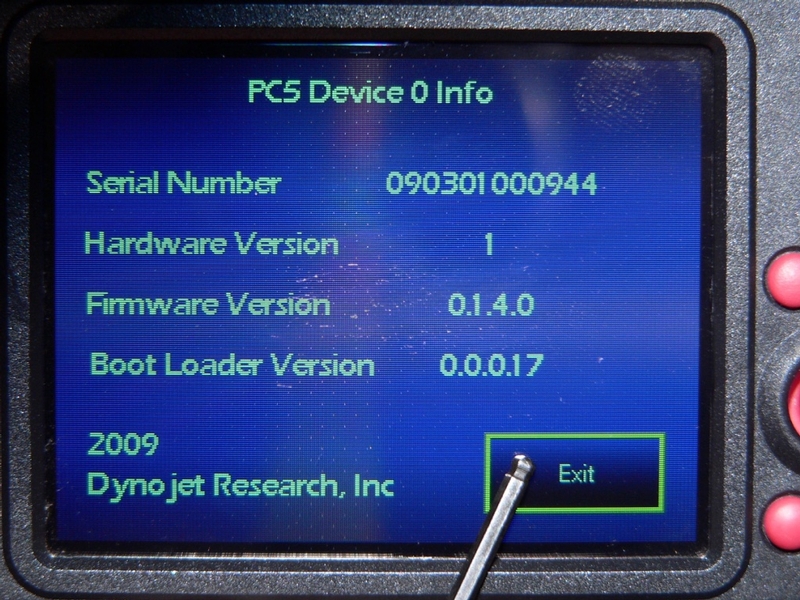Device Setup
Wideband 2 / AutoTune Functions
- AFR and RPM Signal Settings
95. From the Main Menu, touch the Device Setup button to open the the Device Selection screen.
Select Wideband 2 Device 0 from the list of devices.
Touch Select.
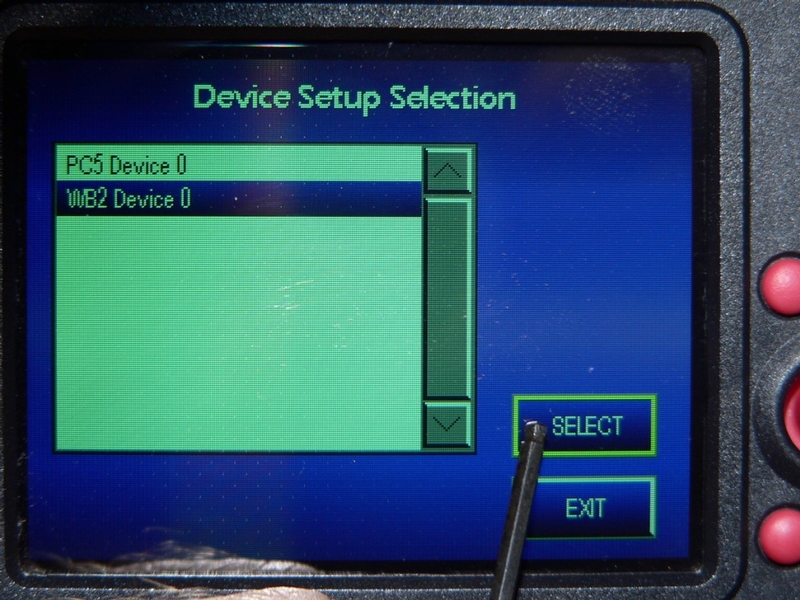
96. The Wideband 2 - 0 Setup screen opens.
Touch the Device Settings button.
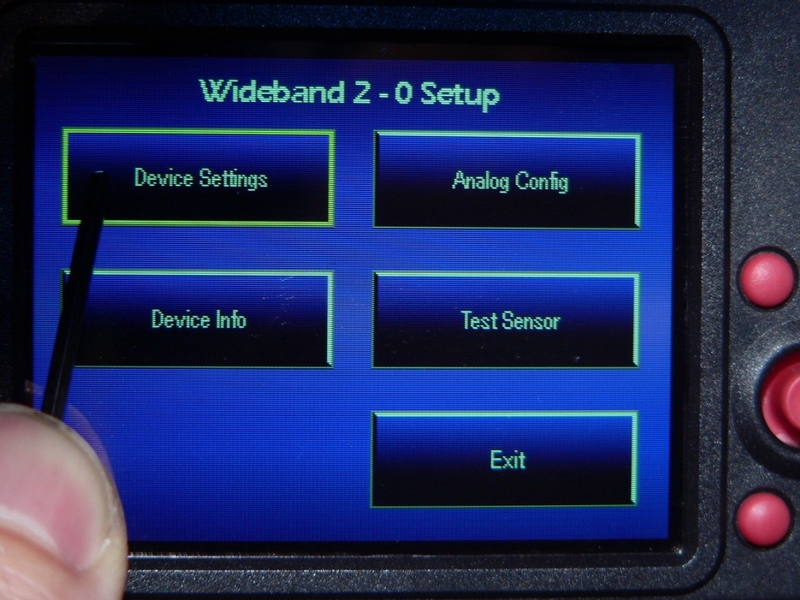
97. The Wideband 2 Device 0 Settings page 1 of 3 screen opens.
There are three pages (screens) of these settings. All settings alter the signal that is received by the LCD from the Wideband 2 or Autotune device. It will probably not be very beneficial or desirable to alter most of the default settings except for advanced tuning practices. Below is a brief description of each setting. You will note many of the settings are for Wideband 2 only. Wideband 2 is equipped with wiring to tap into the tachometer and analog channels. Since Autotune and Wideband 2 have the same type of O2 sensor, both units can be adjusted for the first three settings which effect AFR signal input.
WIDEBAND 2 DEVICE SETTINGS PAGE 1
Display Update Rate
Wideband 2 and AutoTune
Setting Range: 1-20
Default Value: 20
This is how frequently the gauges on the LCD update the most current figures from the previous ones. 1 is the slowest rate. This setting effects all channels of the WB2 or AT-200 device. It may be helpful to view some data on the LCD at a slower rate if the data changes too quickly to read accurately in real time.
Lambda Smoothing
for Wideband 2 and AutoTune
Setting Range: 1-255
Default Value: 10
This setting averages the AFR pulses so that the readings will be more steady and easy to read in real time. This setting effects Lambda readings in the same way. The lower settings will provide the most detailed information with least latency which is best for data logging. Higher settings will cause changes in Lambda and AFR readings to be less jumpy which may be more desirable for viewing in real time.
Stoichiometric AFR
for Wideband 2 and AutoTune
Setting Range: 0-ambient
Default Value: 14.7
The stoichiometric AFR should be changed when using Lambda to tune for fuels other than ordinary gasoline. Stoichiometric AFR is achieved when the exact number of units of air are mixed with one unit of fuel so that complete combustion of fuel and oxygen occurs. No excess fuel or oxygen is left behind after combustion. The stoichiometric AFR for gasoline is 14.7 which is the default setting. You may contact Dynojet for stoichiometric AFRs of other fuels.
O2 Out Threshold
for Wideband 2 only
Setting Range: .9-1.1
Default Value: 1
For using Lambda to tune. Sets the voltage at which the narrow band signal (rich) and wide band signal (lean) occurs. This setting is only for Wideband 2.
The only settings I would consider changing as a beginner would be Lambda Smoothing and perhaps Display Update rate.
Touch the EDIT button after the feature you wish to change the setting of.
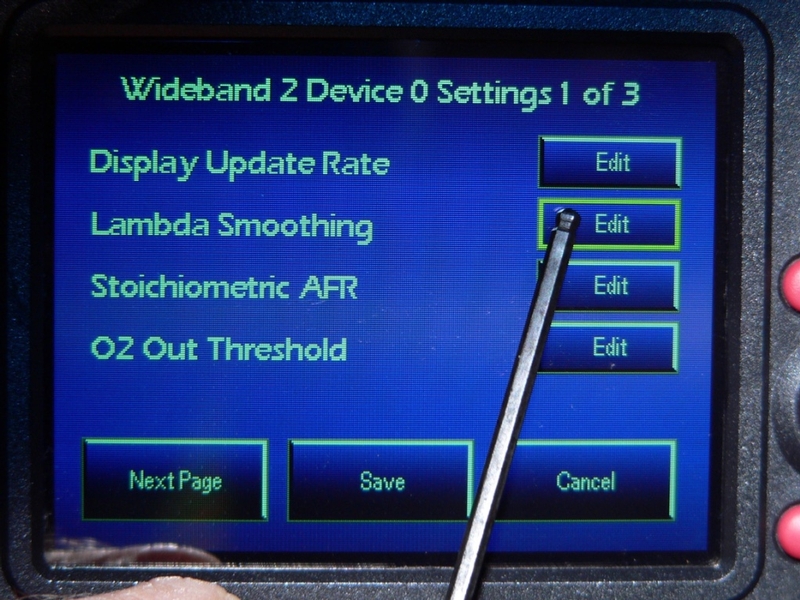
98. The feature’s screen opens displaying the current value and the set value.
Touch the More button to increase the set value or touch the Less button to decrease the set value.
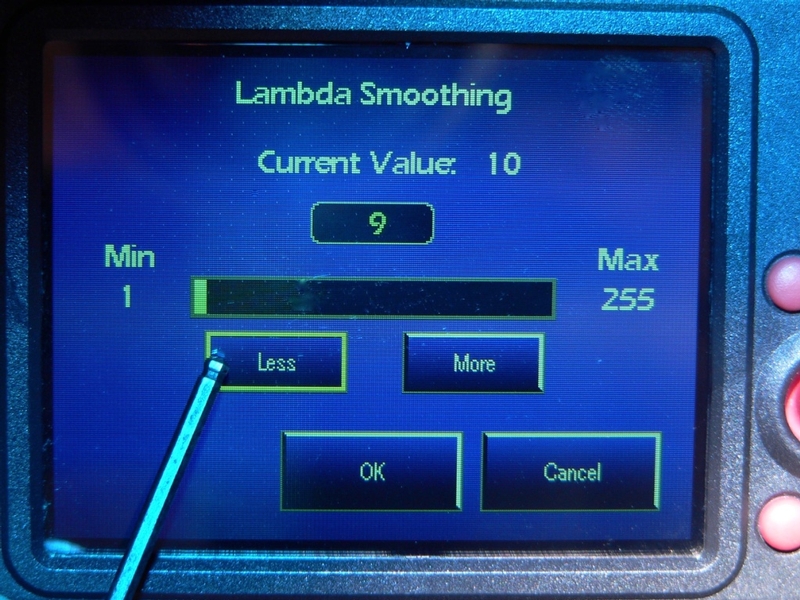
99. Touch OK to accept the set value and return to the Wideband 2 Device 0 Settings screen.
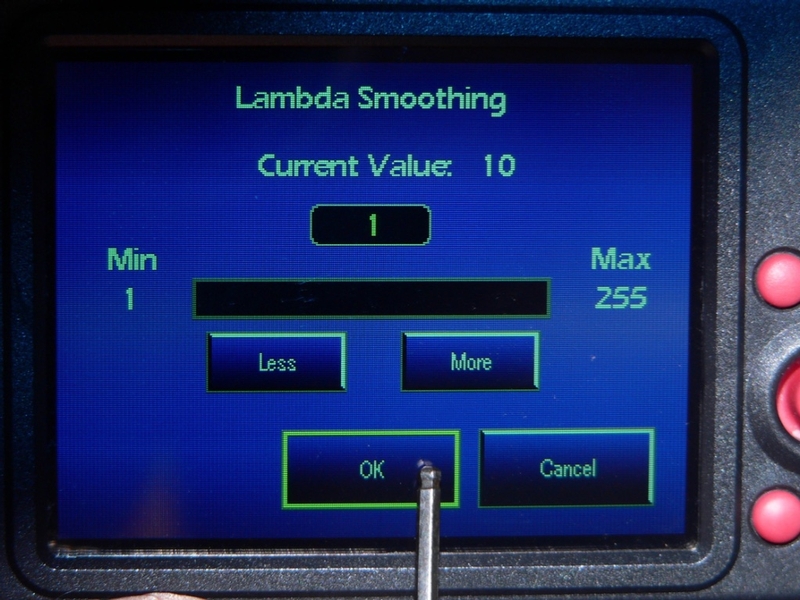
OR
Touch Cancel to retain the current value and return to the Wideband 2 Device 0 Settings screen.
100. From the Wideband 2 Device 0 Settings 1 of 3 screen,
Touch EDIT for the next setting you wish to change the value of and repeat steps 96 through 98.
OR
Touch Save to save the new setting and return to the Wideband 2 - 0 Setup screen.
OR
Touch Cancel to preserve the current values of all features and return to the Wideband 2 - 0 Setup screen.
OR
Touch the Next Page button to advance to page 2 of Wideband 2 Device 0 Settings.
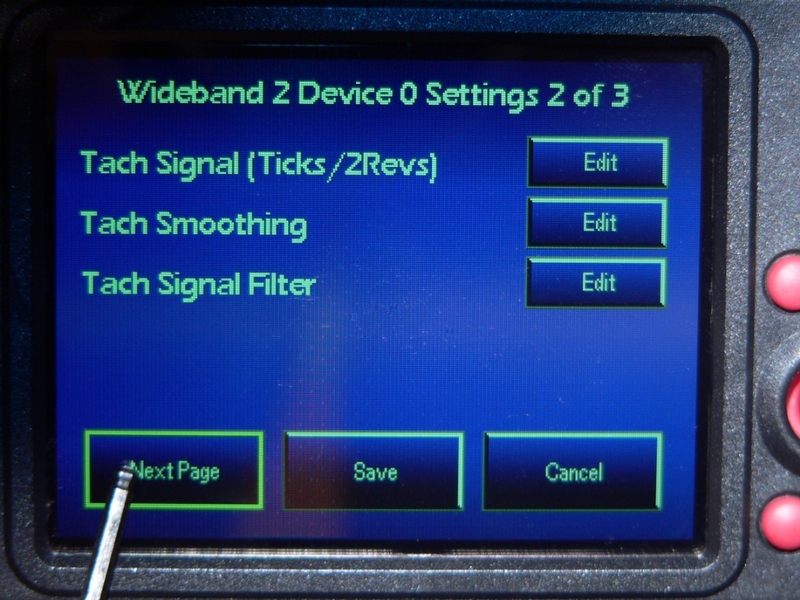
WIDEBAND 2 DEVICE SETTINGS PAGE 2
Tach Signal (Ticks / 2Revs)
for Wideband 2 only
Setting Range: 1-16
Default Value: 1
This changes the multiplier the Wideband 2 uses to interpret the tachometer signal. The multiplier will need to be adjusted to turn the signal into an accurate tachometer reading. I have noticed that Autotune’s tachometer signal only goes to 3000 rpm and the multiplier may be the cause of this. Unfortunately, AutoTune’s tach signal cannot be adjusted but the PCV’s rpm channel works very well.
Tach Smoothing
for Wideband 2 only
Setting Range: 1-16
Default Value: 2
Averages the tachometer signal from the Wideband 2 so that the rpm displays a smooth transition in level on the gauge.
Tach Signal Filter
for Wideband 2 only
Setting Range: 1-255
Default Value: 30
Filters out incorrect rpm inputs. It its possible for AutoTune and Wideband 2 to perceive very incorrect rpm. Though this event usually only happens for one or two tenths of a second, it can effect fuel trims.
101. Adjust any of the Wideband 2 settings on page 2 of Wideband 2 Device 0 Settings. Follow the procedures outlined in steps 97 through 99.
Touch the Next Page button to advance to page 3 of Widebandband 2 Device 0 Settings.
102. The features on page 3 of Widebandband 2 Device 0 Settings may be either turned ON or turned OFF by selecting or deselecting the bullet point for each. The Bias Tach Signal feature can only be selected when Attenuate Tach Signal has been turned ON.
WIDEBAND 2 DEVICE SETTINGS PAGE 3
Attenuate Tach Signal
for Wideband 2 only
Setting Range: Active or Inactive
Default Value: Inactive
Reduces the tachometer signal voltage from the Wideband 2 overall to filter out noise.
Bias Tach Signal
for Wideband 2 only
Setting Range: Active or Inactive
Default Value: Inactive
Biases the tach signal to a higher voltage.
Rising Edge
for Wideband 2 only
Setting Range: Active or Inactive
Default Value: Inactive
Allows the Wideband 2 to measure the rising edge on the RPM voltage signal.
Touch Save to save edits on all three pages of Wideband 2 Device 0 Settings and return to the Wideband 2 - 0 Setup screen.
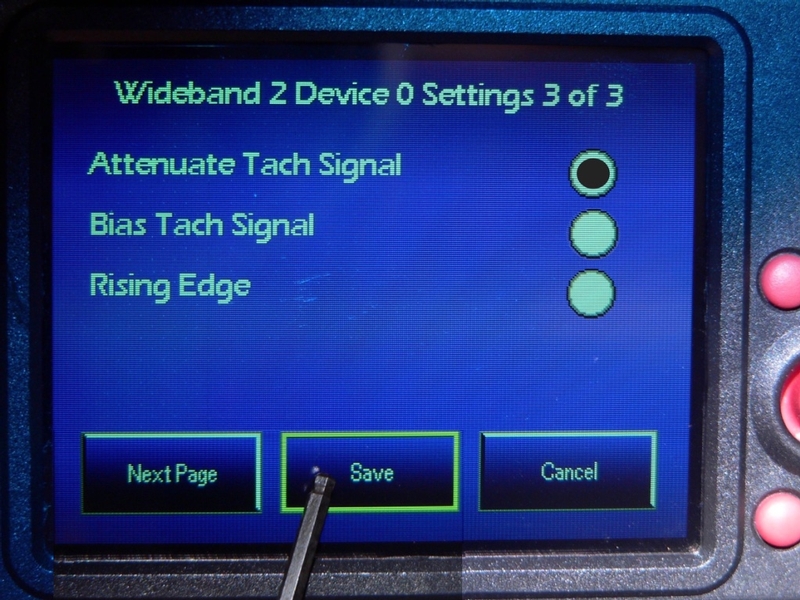
OR
Touch Cancel to preserve the current values of all features on all three pages and return to the Wideband 2 - 0 Setup screen.
OR
Touch the Next Page button to return to page 1 of the Wideband 2 Device 0 Settings screen.
Wideband 2 / AutoTune Functions
- Analog Channel Input Configuration
103. From the Wideband 2 - 0 Setup screen, touch the Analog Config button.
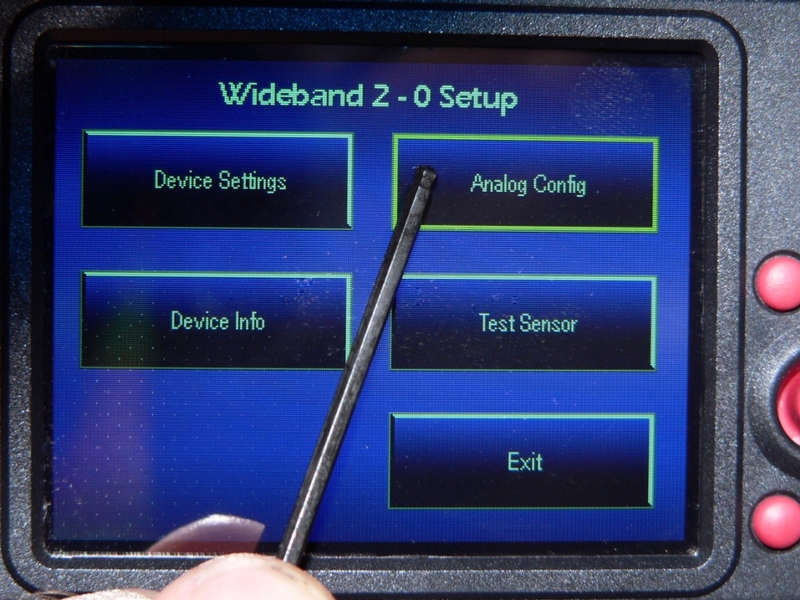
104. The WB2 - 0 Analog Channel Configuration screen opens.
Select the bullet point for Throttle Position to enable throttle position calibration through the WB2/AT device.
Touch the Calibrate Throttle button to open the Throttle Calibration screen.
This function is identical to throttle calibration through the PCV. See steps 77 through 79 of PCV Functions to calibrate throttle position through the WB2/AT device.
Select User Defined to disable throttle position calibration through the WB2 and create a custom analog channel instead. In order to display on the gauges screen, the analog channel will require wiring to the WB2 device from a 1-5 V source such as the oil temperature sensor or the air box temperature sensor. Autotune modules are not equipped with the wiring for analog channel input. The User Defined selection will only work with Wideband 2.
Touch Save to save the selection and return to the Wideband 2 - 0 Setup screen.
Touch Cancel to return to the Wideband 2 - 0 Setup screen without making changes.
Touch Channel Setup to proceed and open the Wideband 2 Device 0 Analog Channel screen.
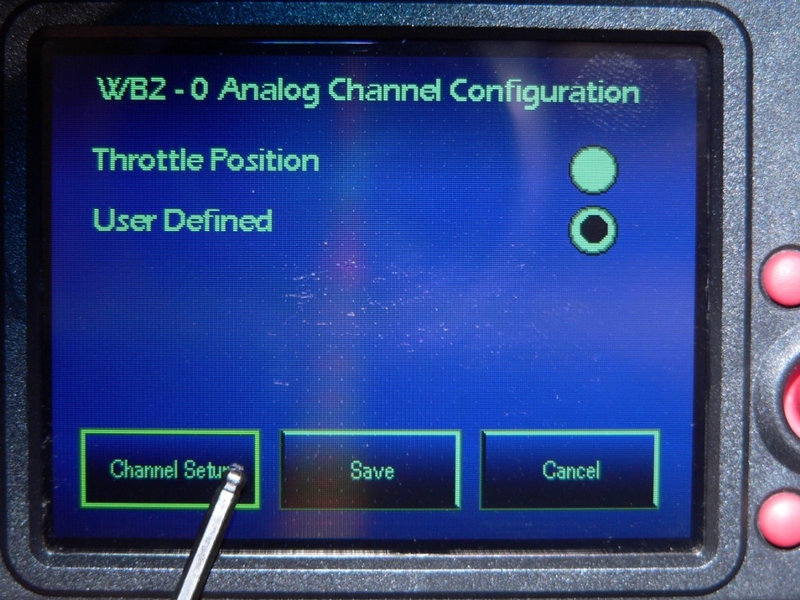
105. The Wideband 2 Device 0 Analog Channel screen opens.
Touch EDIT for Channel Name.
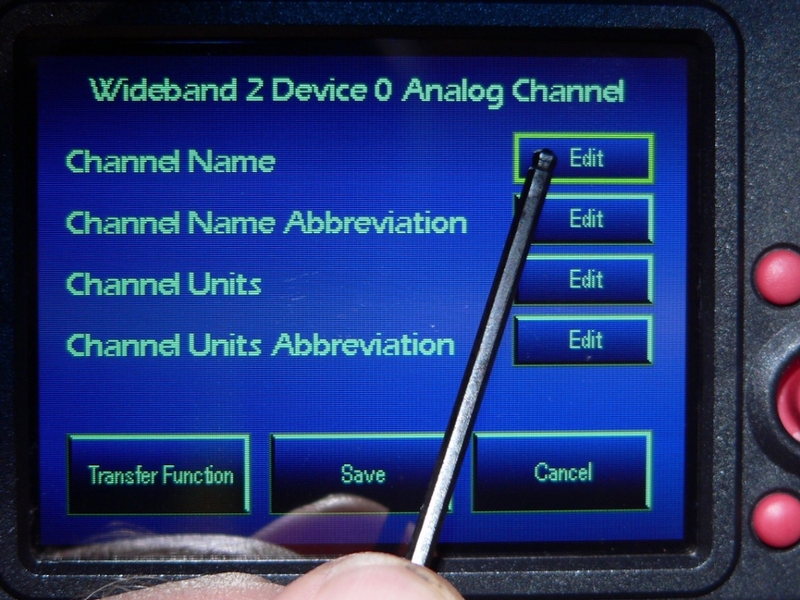
106. Use the alphanumeric keypad that opens to type the name of your custom channel. There is a limit of 20 characters. You may type lowercase letters and numerals by touching a key rapidly in succession or choose from several symbols by touching the * key. The name you type will appear in the menu of channel selections for the Wideband 2 device.
Touch the OK button.
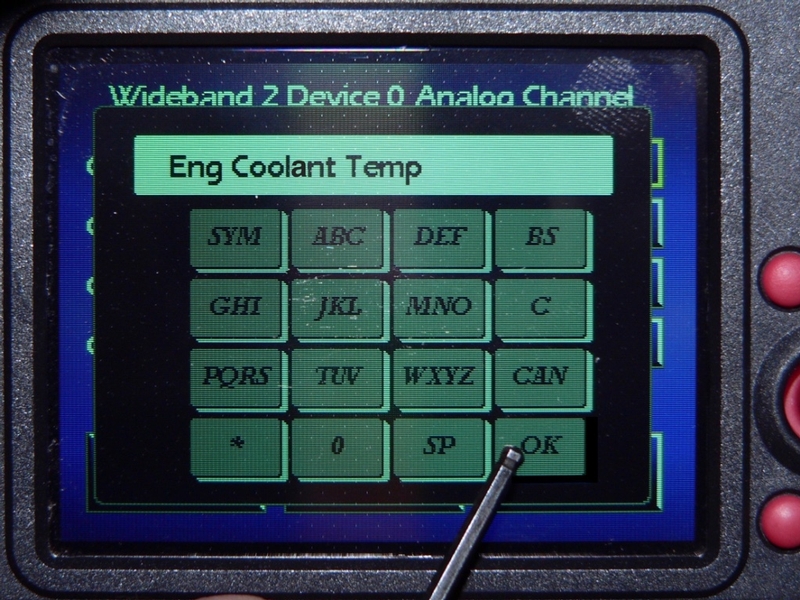
107. The alphanumeric keypad will disappear.
Touch the EDIT button for Channel Name Abbreviation.
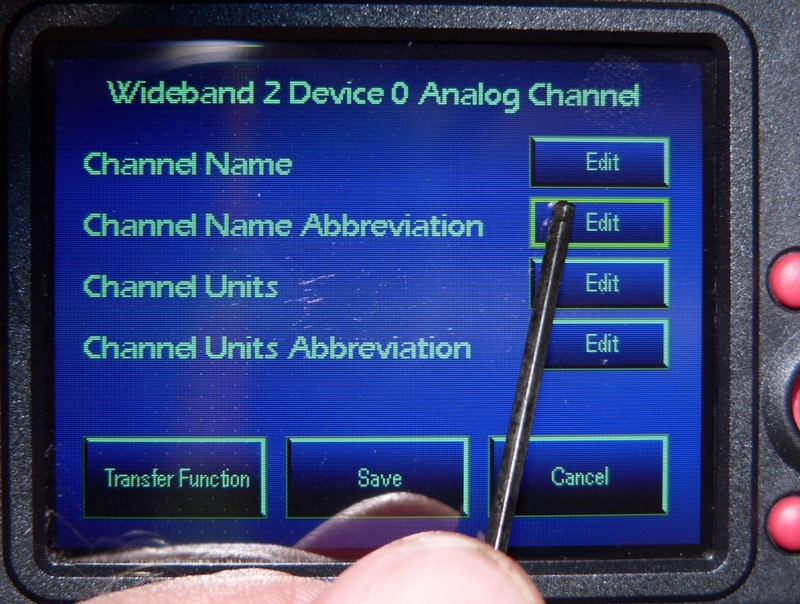
108. Use the alphanumeric keypad that opens to type the name abbreviation of your analog channel. There is a limit of 7 characters. This abbreviation will appear on the channel’s gauge in the Gauge Panel screen.
Touch the OK button.
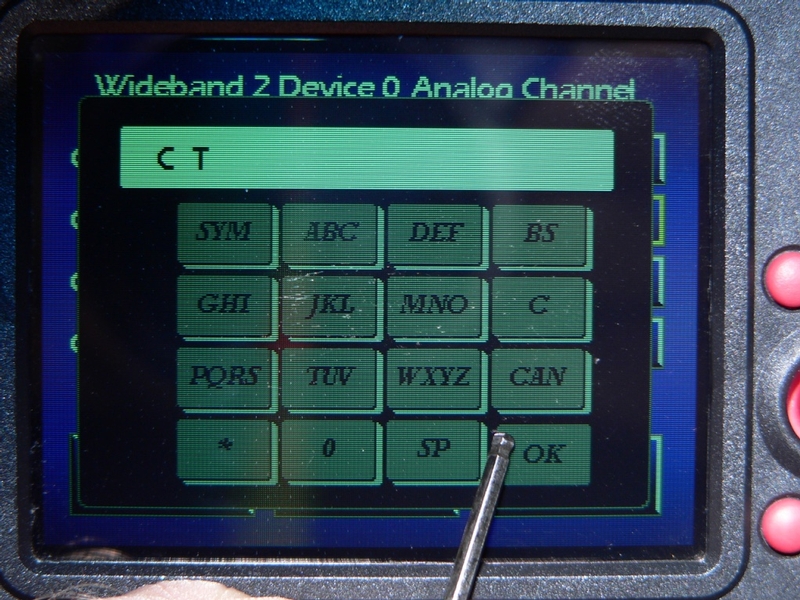
109. The alphanumeric keypad will disappear.
Touch the EDIT button for Channel Units.
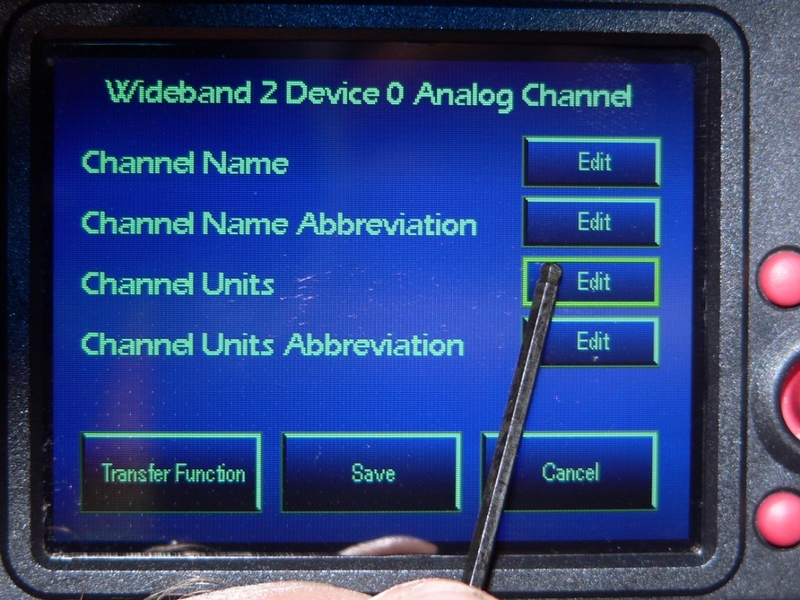
110. Use the alphanumeric keypad to type the name of the units that will be indicated on the analog channel’s gauge. There is a limit of 10 characters. This name will appear in the menu of channel selections for the Wideband 2 device.
Touch the OK button.
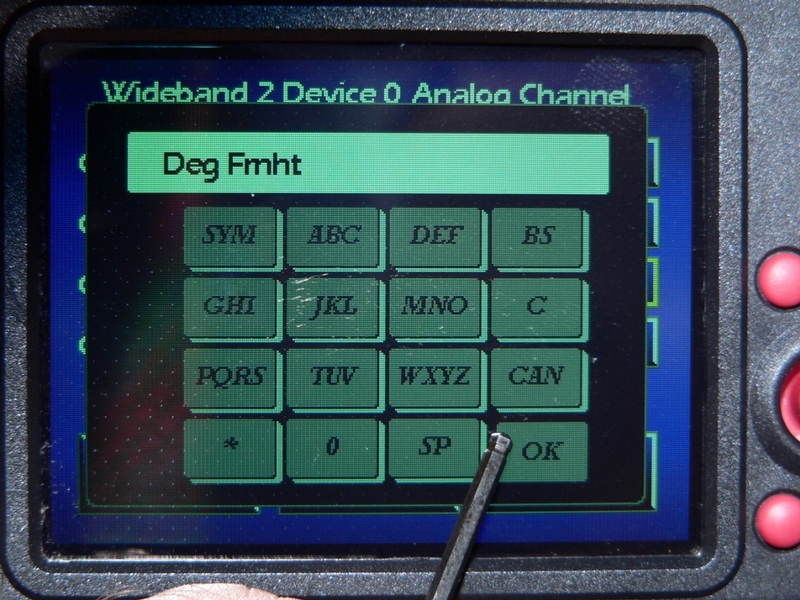
111. The alphanumeric keypad will disappear.
Touch the EDIT button for Channel Units Abbreviation.
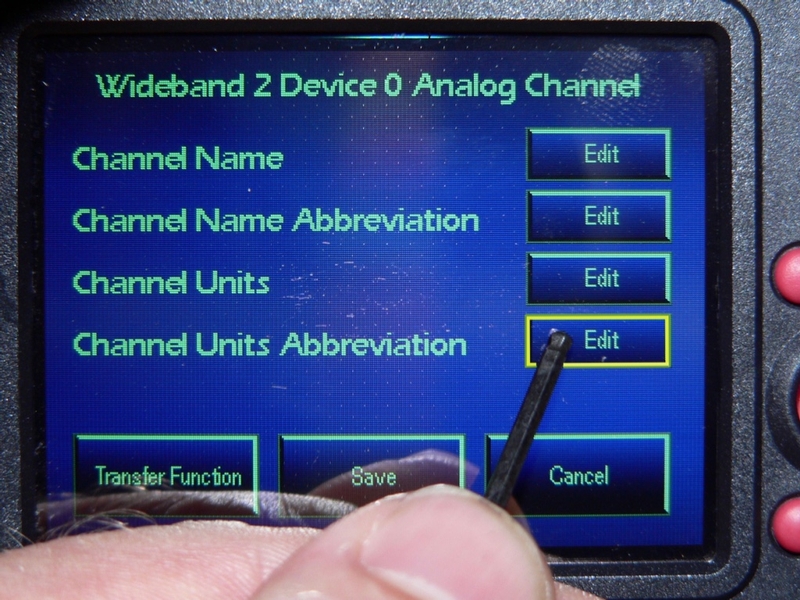
112. Use the alphanumeric keypad that opens to type the units abbreviation of your analog channel. This abbreviation will appear on the channel gauge in the gauges screen. There is a limit of 7 characters.
Touch the OK button.
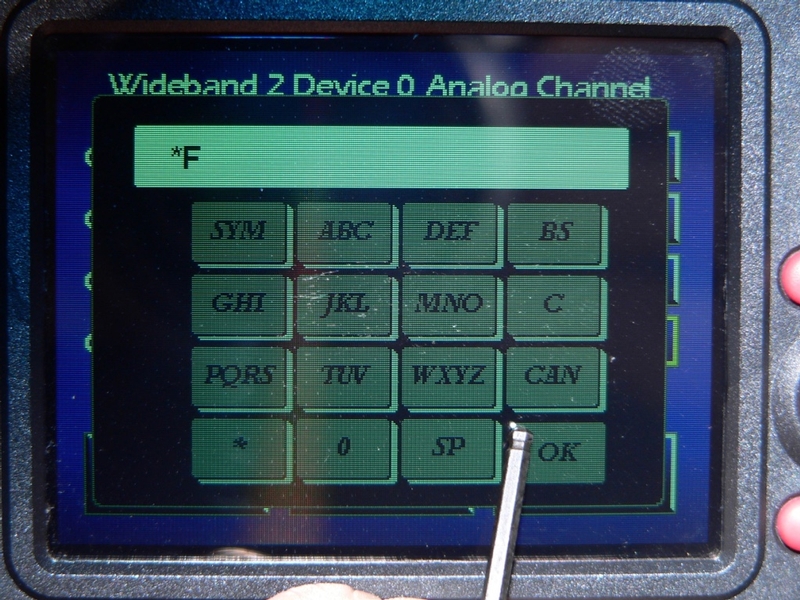
113. The alphanumeric keypad disappears.
Touch the Save button to save the names and abbreviations entered for the analog channel and return to the WB2 - 0 Analog Channel Configuration screen.
OR
Touch the Cancel button to make no changes and return to the WB2 - 0 Analog Channel Configuration screen.
OR
Touch the Transfer Function button to proceed with setting up the analog channel.
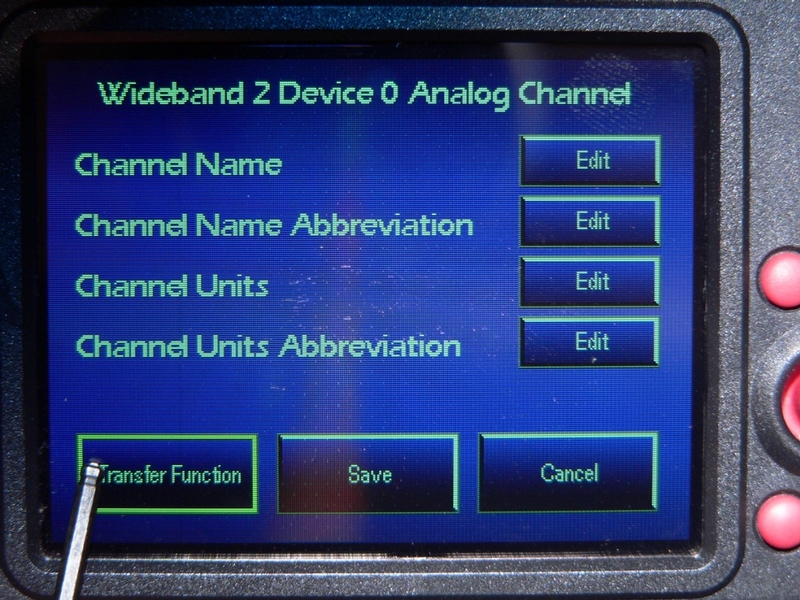
114. The Wideband 2 Channel Transfer Function screen opens.
You will either need to test the voltage of the analog channel or do some trial and error settings to calibrate the channel’s voltage to the scale of units you intend to use for the channel’s gauge.
I did some basic math to come up with the numbers I entered for the hypothetical analog channel I have created for demonstration. I have Autotune so the analog channel is not supported even if it is set up.
0° F************0v**************0% gauge reading
32° F************.33v**********0% gauge reading
141° F*********1.5v************50% gauge reading
195.5° F*******2.25v***********75% gauge reading
250° F*********3v**************100% gauge reading
Assuming the coolant has a 0-3 volt sensor with 0v being transmitted at 32 degrees Fahrenheit and colder, a max gauge reading of 250° F would display when the max 3v was transmitted.
The lowest reading on the gauge scale will be 32 F at .33v.
The highest reading on the gauge scale will be 250° F at 3v.
With a voltmeter on the coolant temp sensor and a thermometer taped to the radiator, I could determine what voltage was transmitted at a low temp point and a high temp point. I guess I probably would not try to get the coolant temp as hot as 195° F but this is just hypothetical. I could have used X voltage at 66° and Y voltage at 155° and that would have given the LCD enough info to calibrate meaningful numbers on the gauge display. When calibrating using two values, it’s usually best to shoot for the highest and lowest practical readings you can get.
Touch the button for the first voltage level.
Use the numeric keypad to enter the a number for the first voltage level (no matter how you get it, by taking a logical guess or by measuring with a voltmeter).
Touch the button for the first gauge reading.
Use the numeric keypad to enter the number of units that correspond to the first voltage level.
Now do the same for a second voltage level which will correspond to a different gauge reading.
Touch the OK button to accept the voltages and units entered and return the Wideband 2 Device 0 Analog Channel screen.
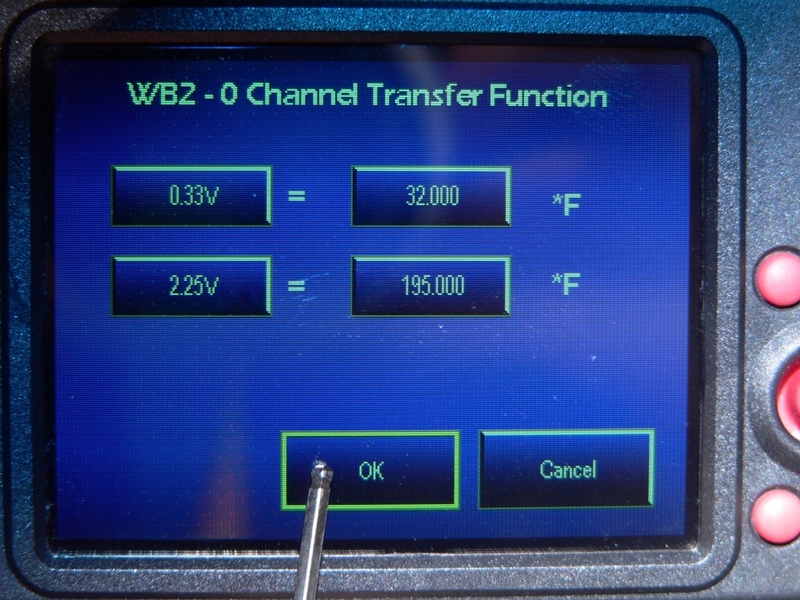
OR
Touch Cancel to return the Wideband 2 Device 0 Analog Channel screen with no changes to the channel transfer function.
115. The Wideband 2 Device 0 Analog Channel screen opens.
Touch Save to save all entries for channel name, units, abbreviations, channel transfer calibrations and return to the WB2 - 0 Analog Channel Configuration screen.
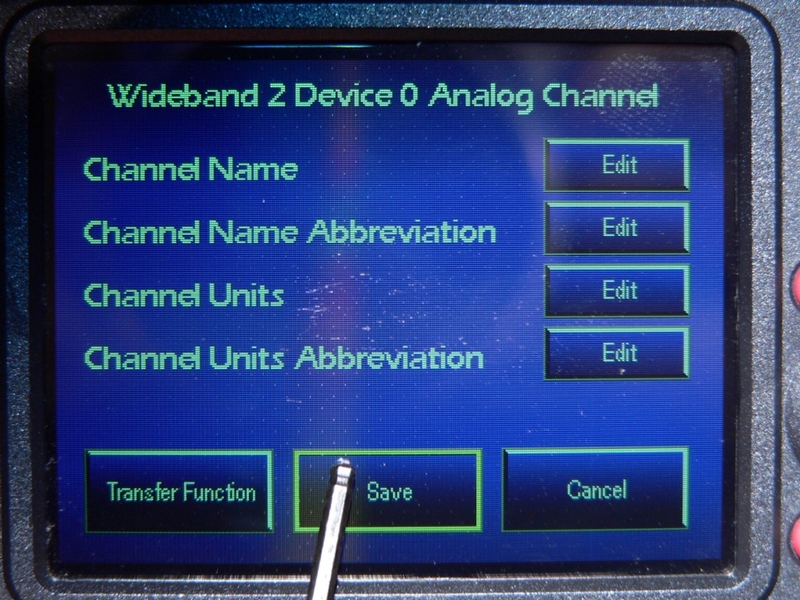
OR
Touch Cancel to return to the WB2 - 0 Analog Channel Configuration screen with no changes to channel name, units and abbreviations.
116. The WB2 - 0 Analog Channel Configuration screen opens.
Touch Save to save the selected channel (analog or User Defined) and return to the Wideband 2 - 0 Setup screen.
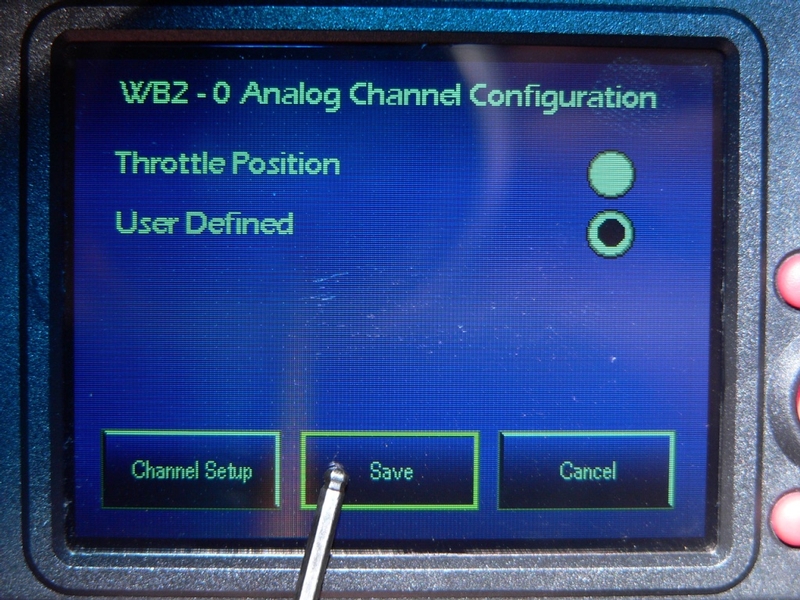
OR
Touch Cancel to restore whatever channel had previously been selected and return to the Wideband 2 - 0 Setup screen.
117. Touch the Exit button on the Wideband 2 - 0 Setup screen to return to the Main Menu.
From the Main Menu, touch Gauge Setup > Gauge template > EDIT > Channel > WB2 Device 0
You will now see your analog channel listed in the Channel Select menu.
Select your analog channel form the Channel Select menu.
Touch the Select button.
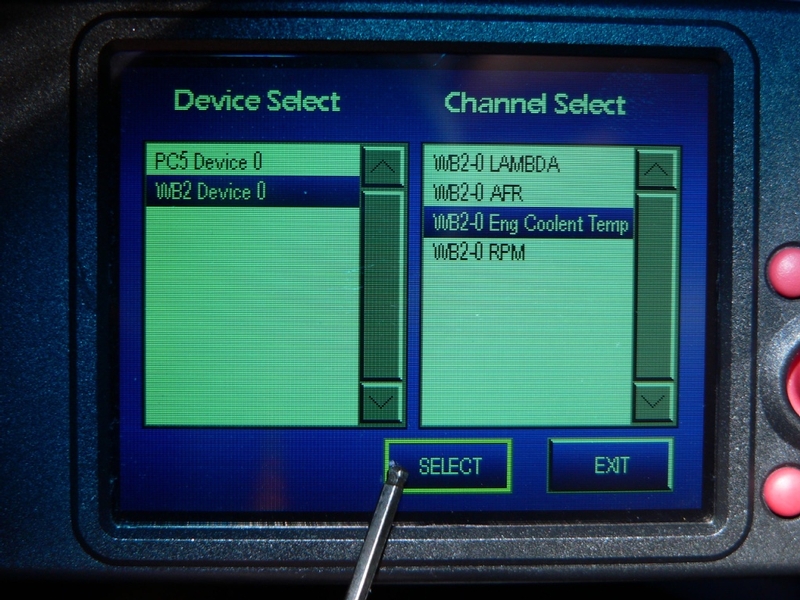
Refer to Gauge Setup, steps 19 through 54 to complete the procedures for setting up the gauge for your analog channel.
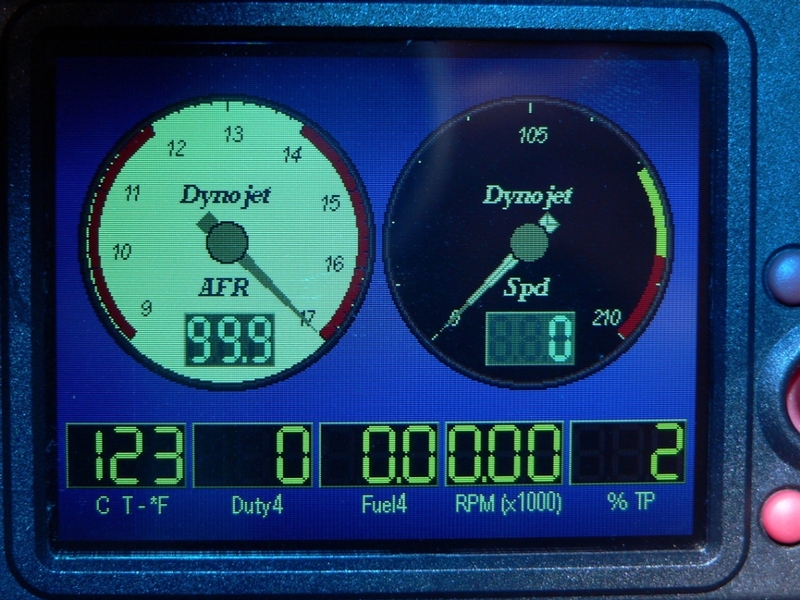
The abbreviation for my analog channel, C T appears with the abbreviation for it’s units, *F below digital gauge #5. It actually appears to be functioning accurately a short time after shutting the engine down. This is only a coincidence because I have no auxiliary wiring and Autotune which I have installed does not have an analogue input feature like Wideband 2.
Wideband 2 / AutoTune Functions
- WB2 / AT Device Information
118. From the Main Menu, touch Device Setup > WB2 Device 0 > Select > Device Info
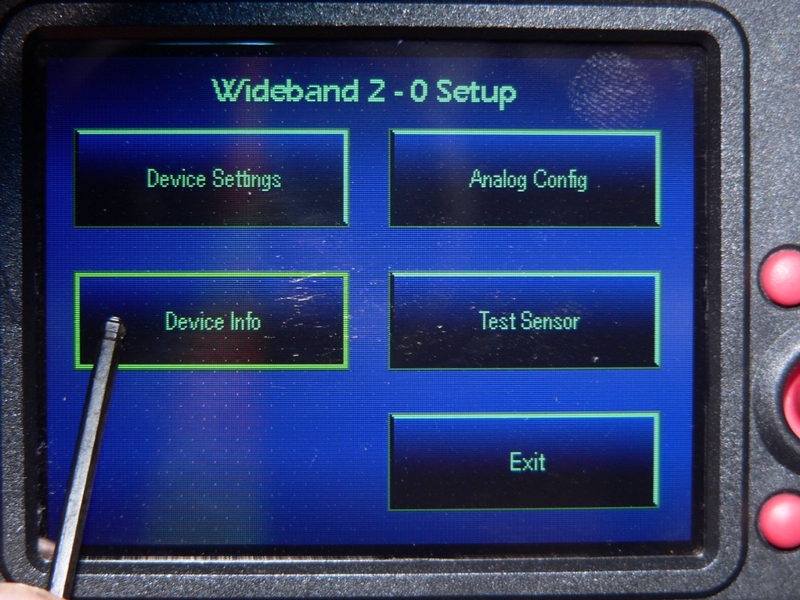
The WB2 Deice Info box opens showing firmware and serial number info for the WB2 /AT device in the network.
Touch the Exit button to return to the Wideband 2 -0 Setup screen.
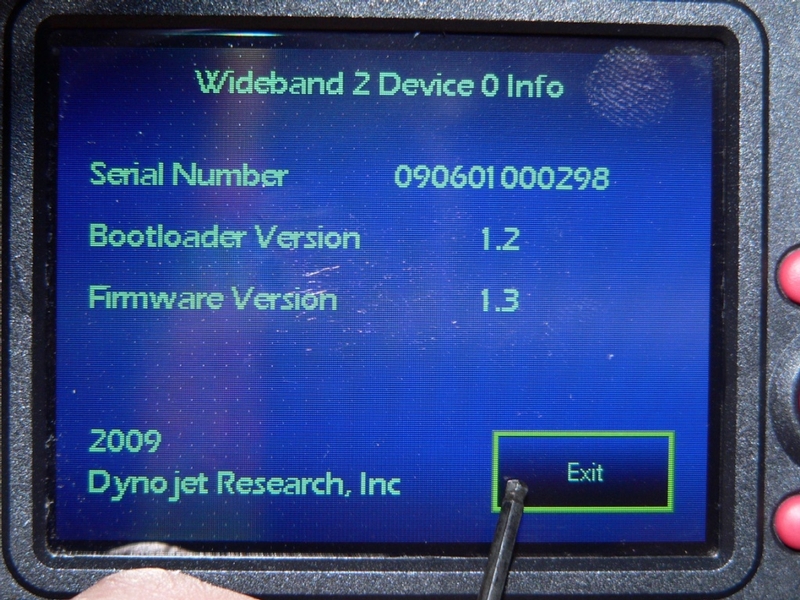
Wideband 2 / AutoTune Functions
- O2 Sensor Test
119. The Wideband 2 -0 Setup screen opens.
Touch the Test Sensor button.
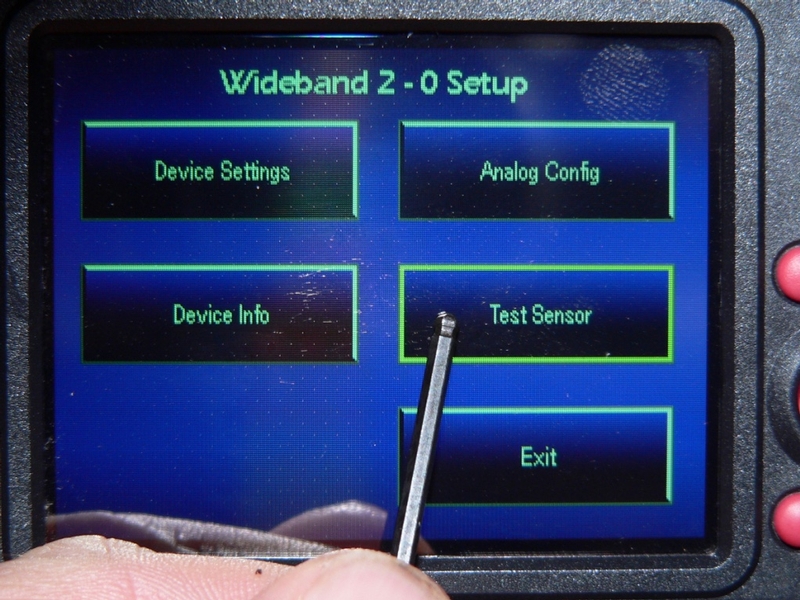
Dynojet instructions say it is very important to remove the sensor and wave it in clean air to do the test. I have always tested with the O2 sensor while installed with the engine off and cold. The results seem to be consistent and reliable. You could have the WB2/AT module in view while testing with the LCD so that the test light on the module may be viewed but then you might as well use the O2 sensor test button on the module to conduct the test (see the concluding note in AutoTune Underseat Install).
120. The Wideband 2 - 0 Sensor Test screen will open.
Touch the Start Test button.
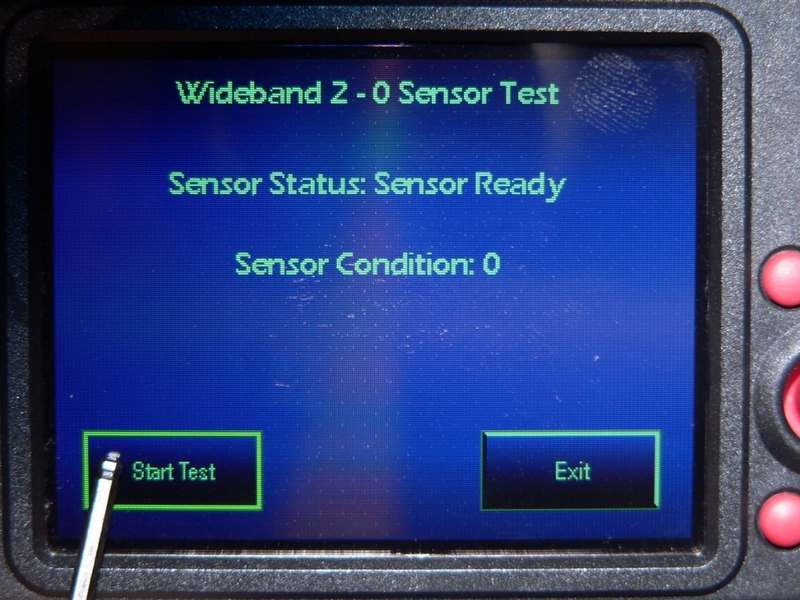
121. If you have the O2 sensor removed from the exhaust, wave it in the air while the test proceeds. It may take up to 20 seconds for a cold sensor to warm up enough to complete the test.
Read the test sensor number after Sensor Condition. You may also count the number of blinks registered on the test light of the WB2/AT device.
Refer to the chart below to compare your geological elevation to the number displayed on the LCD. If the sensor is out of range, the Sensor Condition displayed on the LCD will read XXX. The test light on the WB2/AT module will also blink repeatedly. If the sensor fails the test, replace it with a new one.
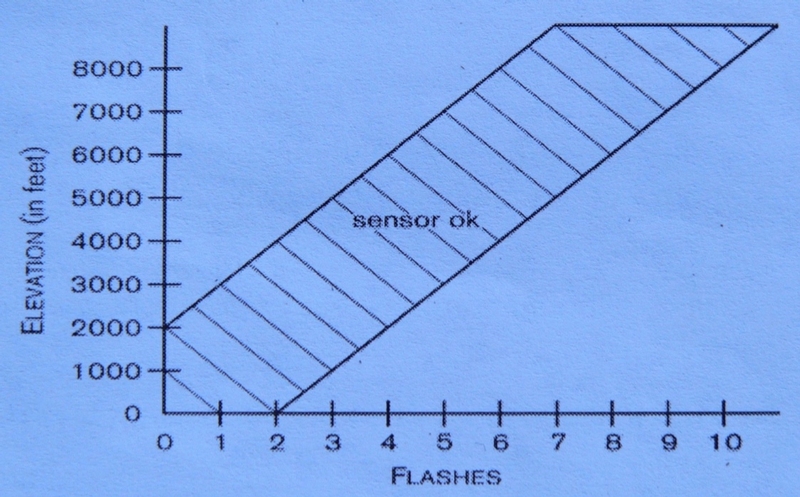
Touch the Exit button to return to the Wideband 2 - 0 Setup screen.
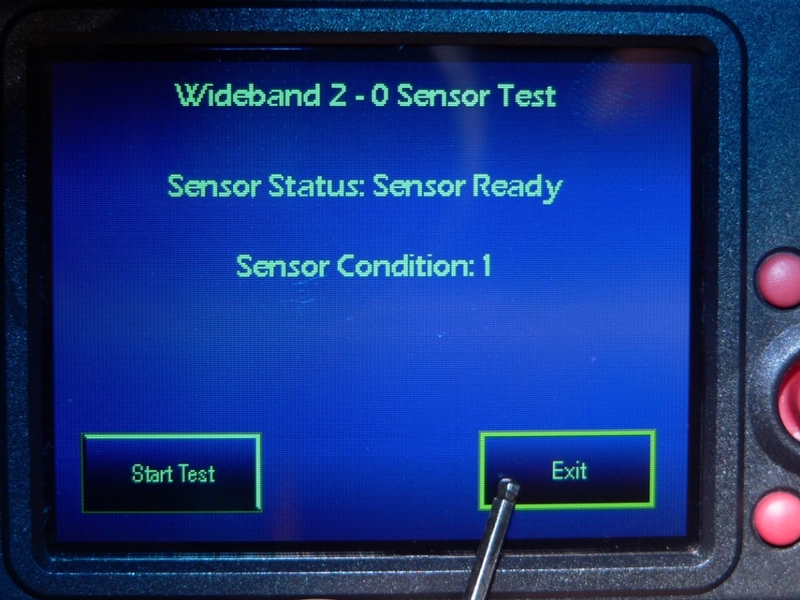
122. Touch Exit to return to the Main Menu.
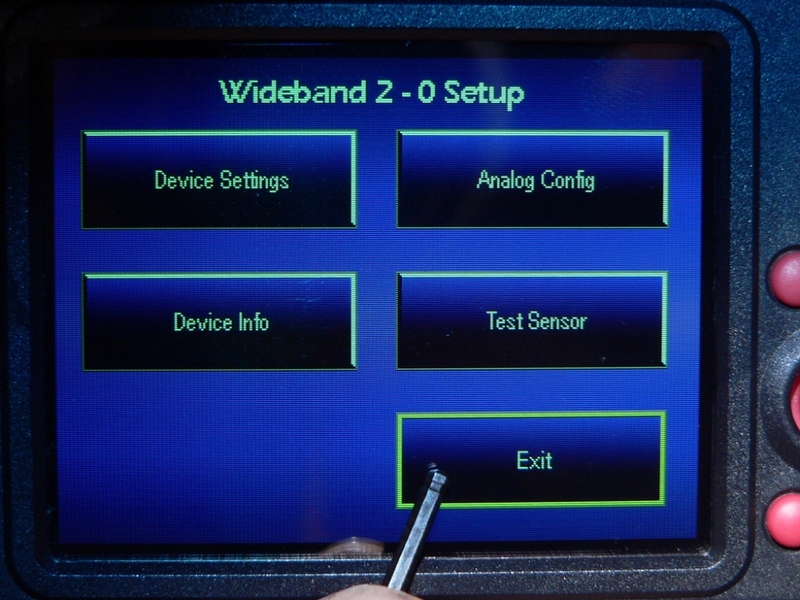
* Last updated by: Rook on 1/26/2018 @ 5:53 AM *
'08 MIDNIGHT SAPPHIRE BLUE Now Deceased
